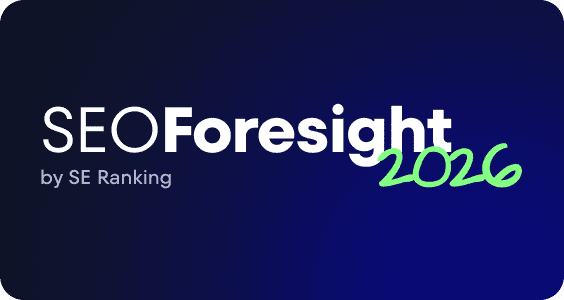AI Overviews research: Media presence and paywalled content analysis
AI Overviews (AIOs) are changing how people find news online. Instead of sending users to news websites, they summarize the information directly in the SERPs. This shift brings up important questions about the visibility of news sources (and how much influence they have) in this new search experience.
To answer these questions, we conducted a new research study that looks at how frequently major media outlets appear in AIOs, under what conditions they are featured, and how Google handles paywalled content in its AI responses.
We expect these findings to help us better understand which media outlets AIOs prefer, discover trends in media mentions, and identify possible strategies to increase visibility.
Let’s start by reviewing the research findings.
-
20.85% of AIO responses include at least one citation from a recognized news outlet. Exclusive reliance on news media is extremely rare, occurring in just 0.09% of responses.
-
The BBC, New York Times, and CNN are the top three most cited news outlets, together making up 31% of all media mentions.
-
Overall, AIOs favor a small set of major outlets, with the top 10 receiving almost 80% of all mentions.
-
Outlets like the Financial Times, MSNBC, Vice, TechCrunch, and The New Yorker are cited very infrequently. Collectively, these make up less than 1% of all news-related mentions.
-
The difference between the most and least cited media is huge: in our analysis, the BBC appears 195 times more often than the Financial Times for the same set of keywords.
-
Out of 3,404 analyzed AIOs that link to paywalled content, we found that 69% of responses contain copied segments of 5 or more words, while 2% contain longer copied segments of over 10 words.
-
Over 96% of New York Times citations in AIOs come from behind a paywall, and for The Washington Post, the figure is even higher, at over 99%.
-
When AIOs do cite news media, they average 1.74 citations per response.
-
The average age of cited articles is around three years, showing that AIOs frequently rely on well-maintained evergreen content.
-
While AIOs prioritize newer content (over 55% of citations come from 2024 and 2025), they also pull from older sources when relevant, with some articles dating back over a century.
-
91.35% of news media citations in AIO responses are found in the links block (which lists supporting sources) rather than the text block containing the summary.
-
News-related queries are 2.5 times more likely to include media citations than general ones, with a 20.85% vs. 8.23% inclusion rate.
-
In AIOs, media outlets are four times more likely to be cited with a hyperlink than mentioned by name. But more than 25% of brand mentions (26.74%) still appear without links, often due to AIO sourcing from aggregators rather than original publishers.
-
Around 40% of media URLs mentioned in AIO responses also appear in the top 10 search results for the same keywords.
Disclaimer: This research is intended for informational and exploratory purposes only. It analyzes the citation patterns of media outlets within Google’s AIOs and uses an extensive set of long-tail, media-related keywords.
Please note that variables like keyword selection, choice of news domains, and specific timeframe of analysis may have influenced these findings.
The insights presented reflect our interpretation of the data, but alternative conclusions may also be valid, especially with different methods or perspectives.
How often do AIOs rely on news media sources?
AIOs are Google’s AI-generated summaries that appear at the top of search results. They offer quick answers by pulling information from various websites. While they make search more efficient, some questions remain about how they affect website traffic and the accuracy of linked sources.
Out of the 75,550 AIO responses analyzed, 15,750 included at least one news outlet from our selected list. This represents 20.85% of all responses. In other words, only about one in five AIOs cited a recognized news source.
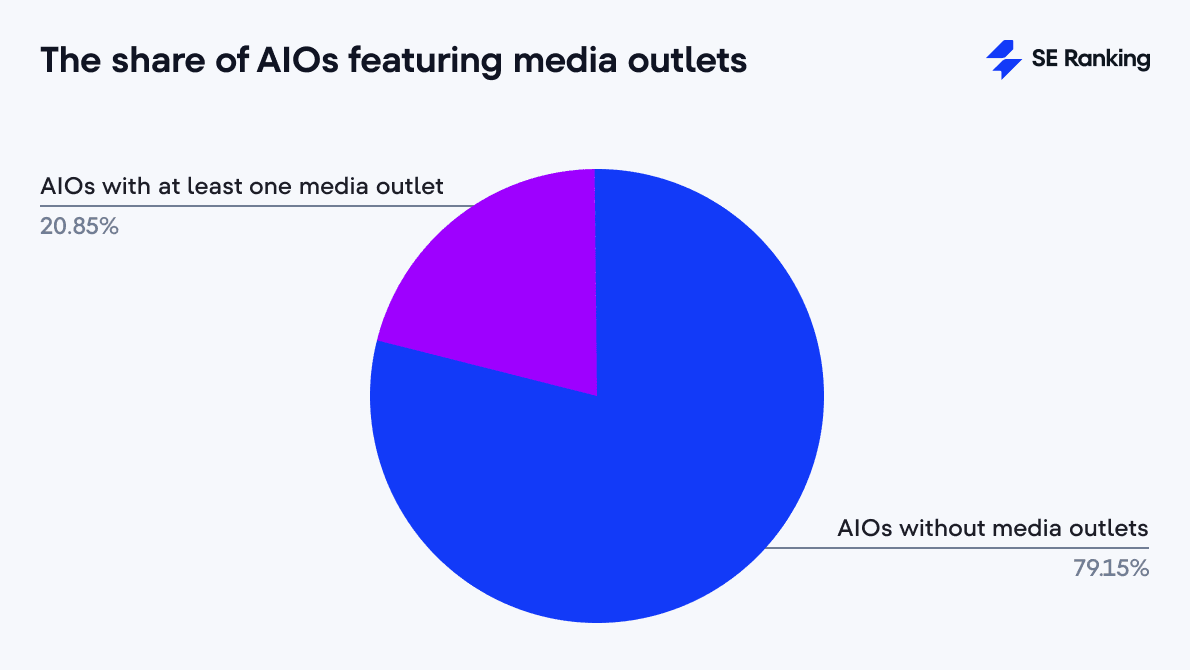
This relatively modest figure is somewhat surprising, considering that the queries were predominantly news-focused.
Particularly, 6,336 included references to more than one media outlet from our list, representing 8.39% of all responses.
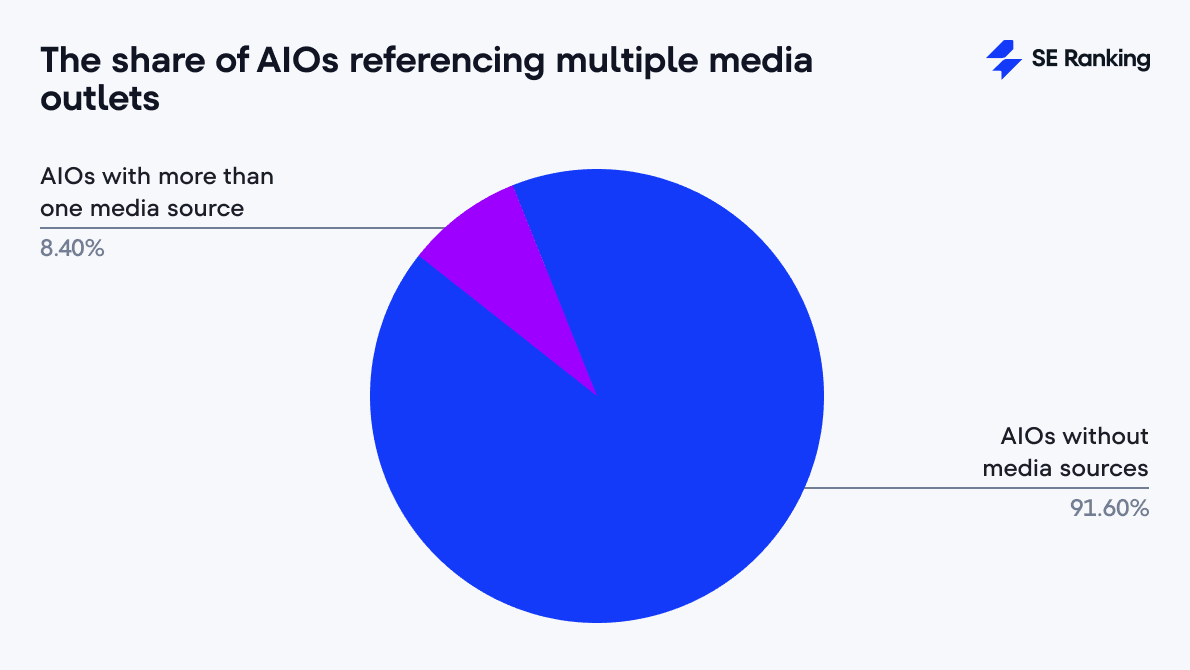
While the overall percentage is not that high, it becomes more meaningful when viewed in context: among the 15,750 responses that cited at least one news source, roughly 40% included multiple media citations. This indicates that when AIOs reference news content, they frequently draw on more than one outlet to support or enrich the answer.
What are the most popular news media outlets in AIOs?
Our analysis shows that media sites are mentioned in AIOs far less frequently than general information platforms such as Google (230,857 mentions), Wikipedia (27,454 mentions), and YouTube (16,070 mentions).
Notably, no news media websites appear in the top 10 most frequently cited domains, despite all keywords relating to newsworthy topics.
But when analyzing only news outlets in AIOs, there’s a clear preference hierarchy. The top 10 most frequently mentioned news domains are:
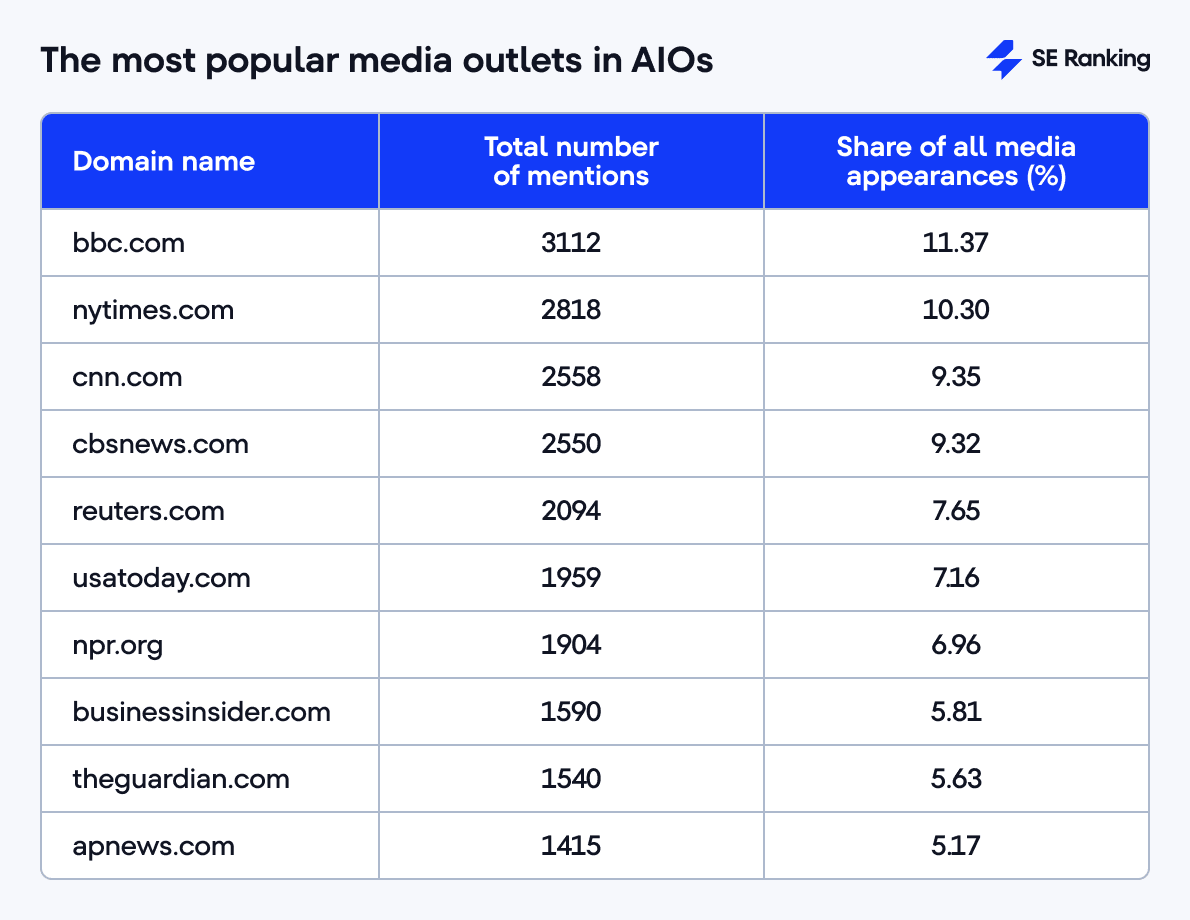
Comparing the top 10 news outlets with the top 10 general domains reveals a striking gap: even the most cited news source, BBC, is mentioned 74 times less than Google and 9 times less than Wikipedia.
Notably, BBC.com (a UK-based news media outlet) leads the list with 11.37% of all mentions, surpassing prominent American sources. Collectively, the top 10 outlets account for 78.72% of all citations. This highlights a strong concentration among a small group of media brands.
As for the distribution of media references in AIOs, it is skewed. The data indicates that AIOs consistently favor a subset of high-profile domains, instead of evenly citing all sources.
The Gini coefficient (a measure of how evenly things are distributed) is 0.54 in this case, where 0 is a perfectly equal distribution and 1 is the maximum inequality. That means there’s a moderate level of imbalance in which sources get cited.
For example:
- The top 3 sources (BBC, The New York Times, and CNN) get 31% of all mentions.
- The top 5 sources get nearly 48%.
- Just 10 websites (about one-third of the ones studied) make up almost 80% of all citations.
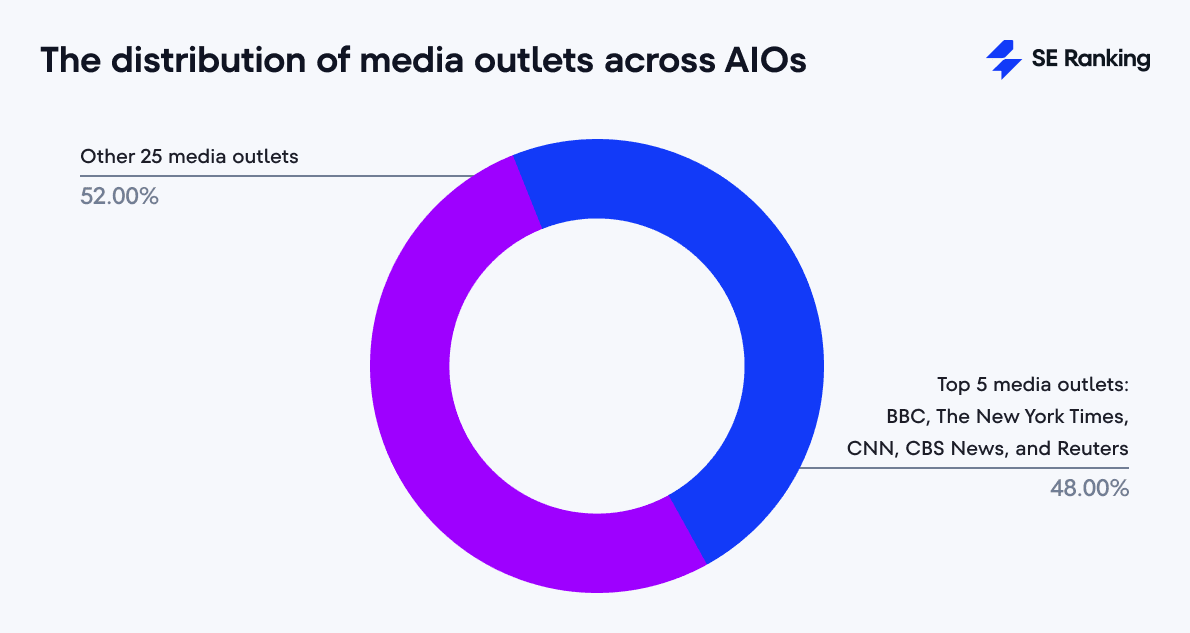
Overall, 12 news outlets (40% of the total) receive almost 90% of mentions, while the remaining 18 outlets share just 10%.
What does this point to?
Well, Google mostly relies on well-known news sources in its AIOs, likely because they are seen as more trustworthy or relevant. This results in a strong bias toward major outlets, with smaller or lesser-known sources rarely mentioned. This makes it harder for these domains to gain visibility.
Which news media outlets are cited the least frequently (or not at all) in AIOs?
No outlet from the list was completely absent; all 30 appeared at least once in AIOs. However, several were cited only rarely:
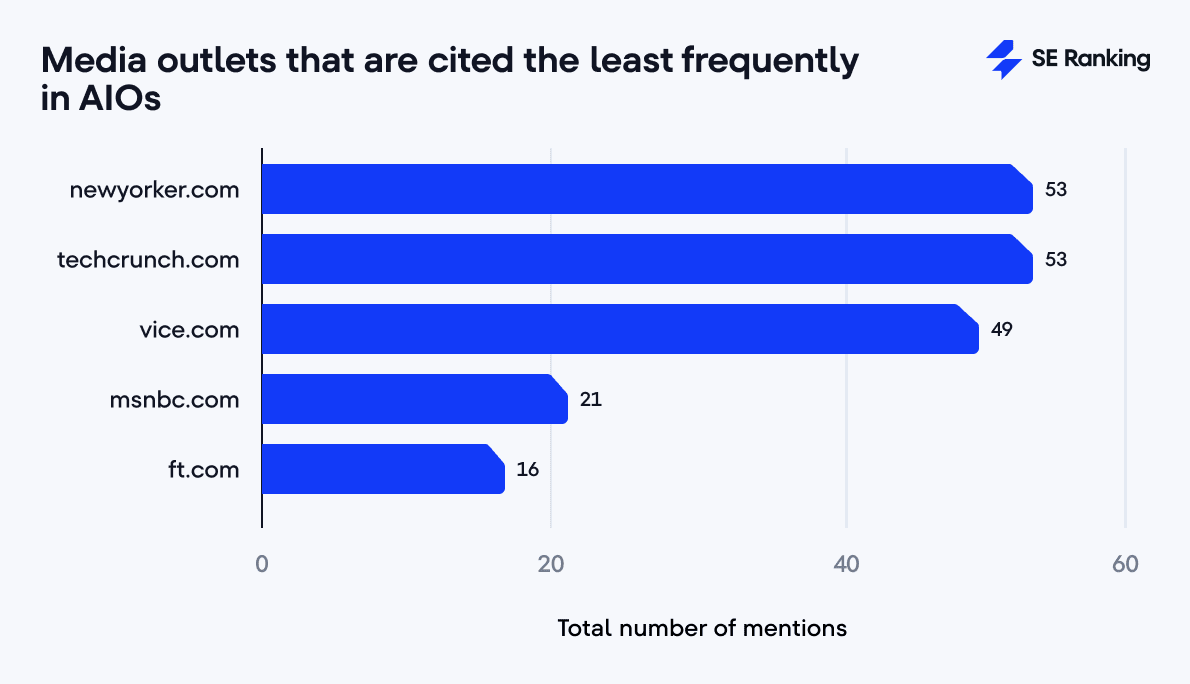
Together, these outlets make up less than 1% of all news-related mentions. This low visibility may be due to several factors, including the niche focus of their content or technical limitations that affect how AIOs index and surface their material.
How are media sources distributed by text and link block mentions in AIOs?
Let’s begin by clarifying the difference between AIO text mentions and link block mentions.
An AIO text mention is a reference or hyperlink located in the AIO’s body text. In contrast, a link mention appears in the right-hand panel (sidebar) of the AIO, typically listed as a source but not directly mentioned in the text.
Our analysis shows a clear preference for link-based attribution. On average, 91.35% of mentions appear in the link block, while just 8.65% are included directly in the AIO text.
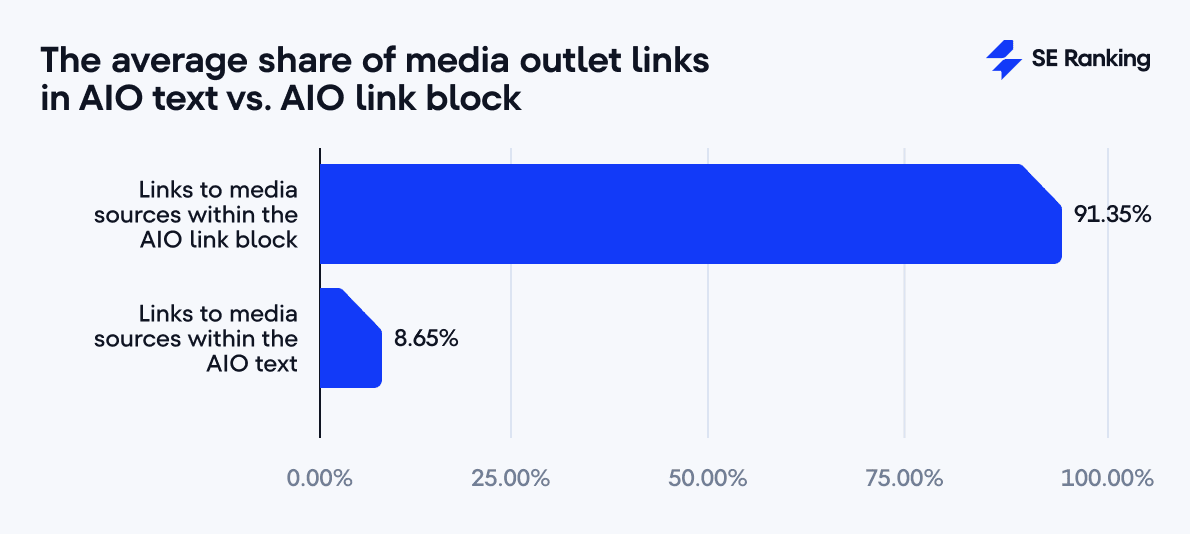
The ratio slightly varies by outlet.
Share of links in the AIO link block
90.33%
Share of links in the AIO body text
9.67%
Share of links in the AIO link block
90.67%
Share of links in the AIO body text
9.33%
Share of links in the AIO link block
89.91%
Share of links in the AIO body text
10.09%
Share of links in the AIO link block
89.22%
Share of links in the AIO body text
10.78%
Share of links in the AIO link block
90.59%
Share of links in the AIO body text
9.41%
Share of links in the AIO link block
92.29%
Share of links in the AIO body text
7.71%
Share of links in the AIO link block
91.70%
Share of links in the AIO body text
8.30%
Share of links in the AIO link block
92.83%
Share of links in the AIO body text
7.17%
Share of links in the AIO link block
92.53%
Share of links in the AIO body text
7.47%
Share of links in the AIO link block
91.31%
Share of links in the AIO body text
8.69%
90.33%
9.67%
90.67%
9.33%
89.91%
10.09%
89.22%
10.78%
90.59%
9.41%
92.29%
7.71%
91.70%
8.30%
92.83%
7.17%
92.53%
7.47%
91.31%
8.69%
Some links to media sources appear far more frequently in the body text of AIOs than others. For instance, Financial Times is featured in 18.75% of relevant cases, Vice at 18.37%, and The New Yorker at 15.09%, twice as much as the average. These publications are known for their in-depth reporting, narrative journalism, and editorial rigor, which may better match Google’s expectations for authority, trustworthiness, and contextual richness.
Moving forward, let’s examine how Google integrates brand names into AIO snippets.
To better understand how different media brands are represented across AIOs, we used our new Brand Mentions Tracking feature in the AI Overviews Tracker, which detects when a brand is mentioned in an AIO, even without a direct hyperlink.
In total, for our keyword sample, we found 5364 brand mentions of our target media outlets, of which 1437 (or 26.74% of all brand mentions) were without hyperlinks (just brand name). This resulted in a 1:5 ratio: links in AIO responses were 5 times more common than brand name mentions.
This can occur when AIOs surface summaries or paraphrased content from aggregators or secondary sources instead of linking directly to the original outlet.
Consider the following examples:
Example 1
Query: latest news on Johnny Depp
AIO fragment:
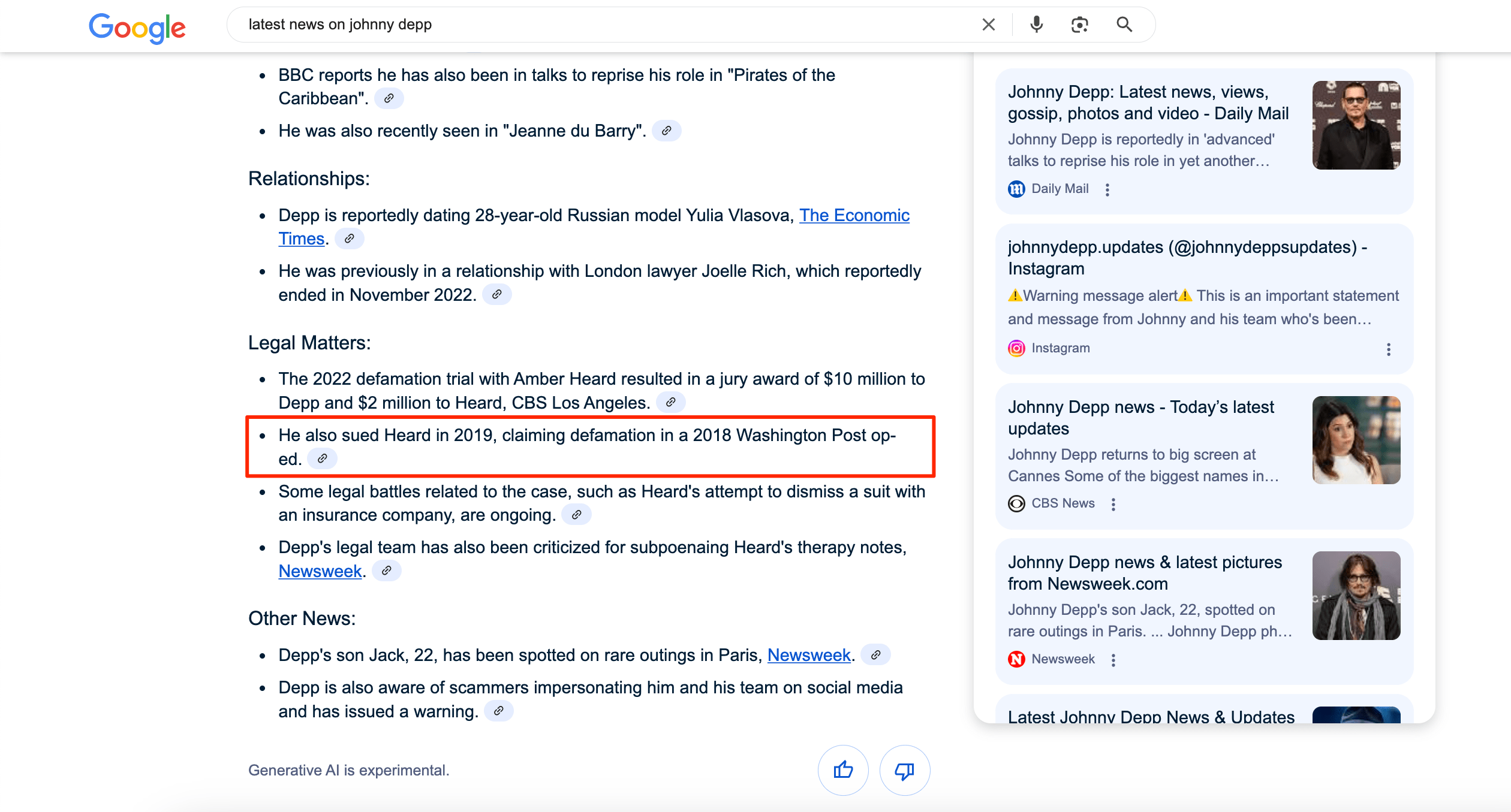
There is no direct link to the Washington Post, even though it’s mentioned. But if we look at the websites the AIO appears to pull information from, such as this article from USA Today, it becomes clear where the reference originated:
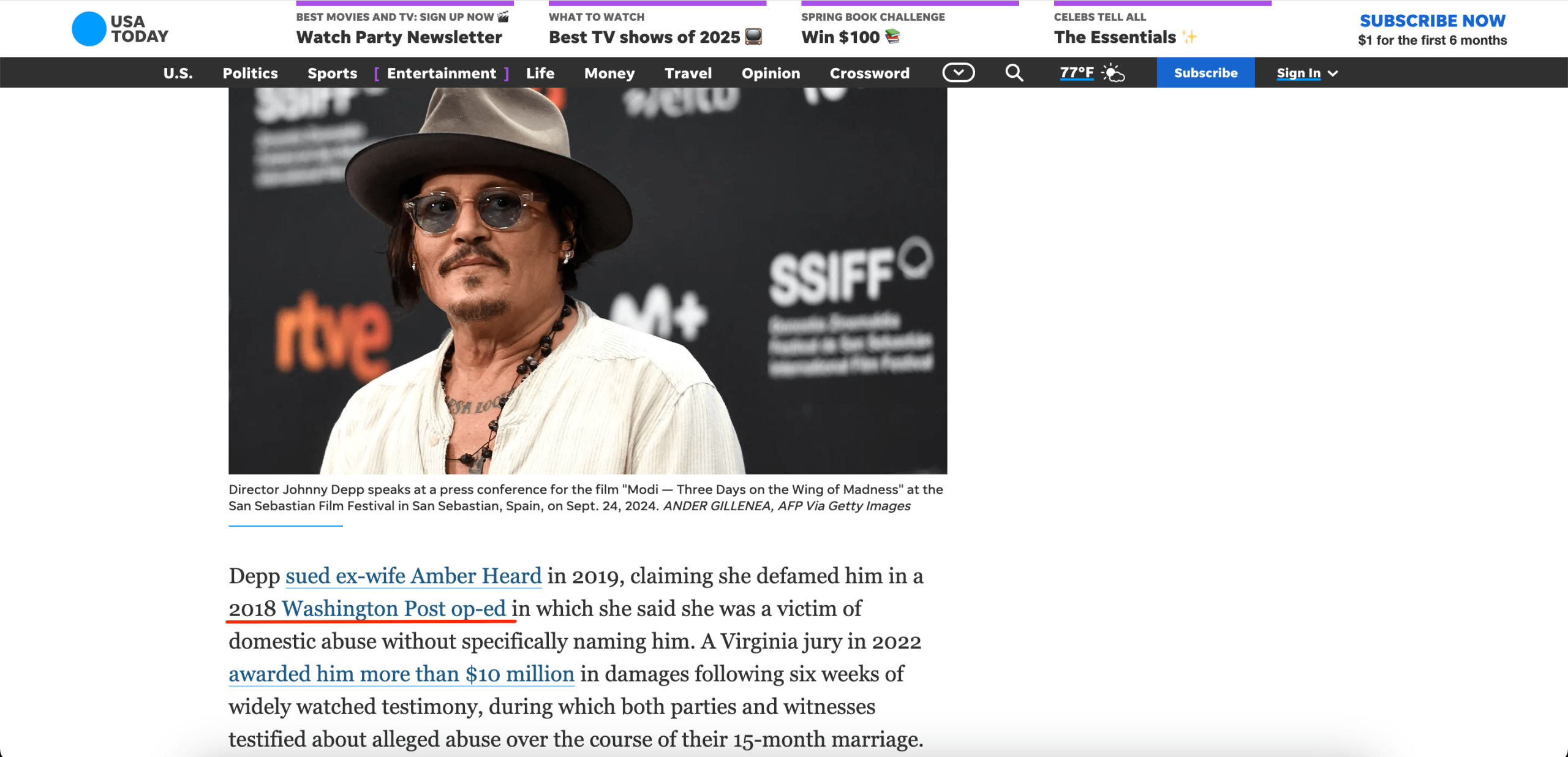
Example 2
Query: who is fighting in the Ukraine war
AIO fragment:
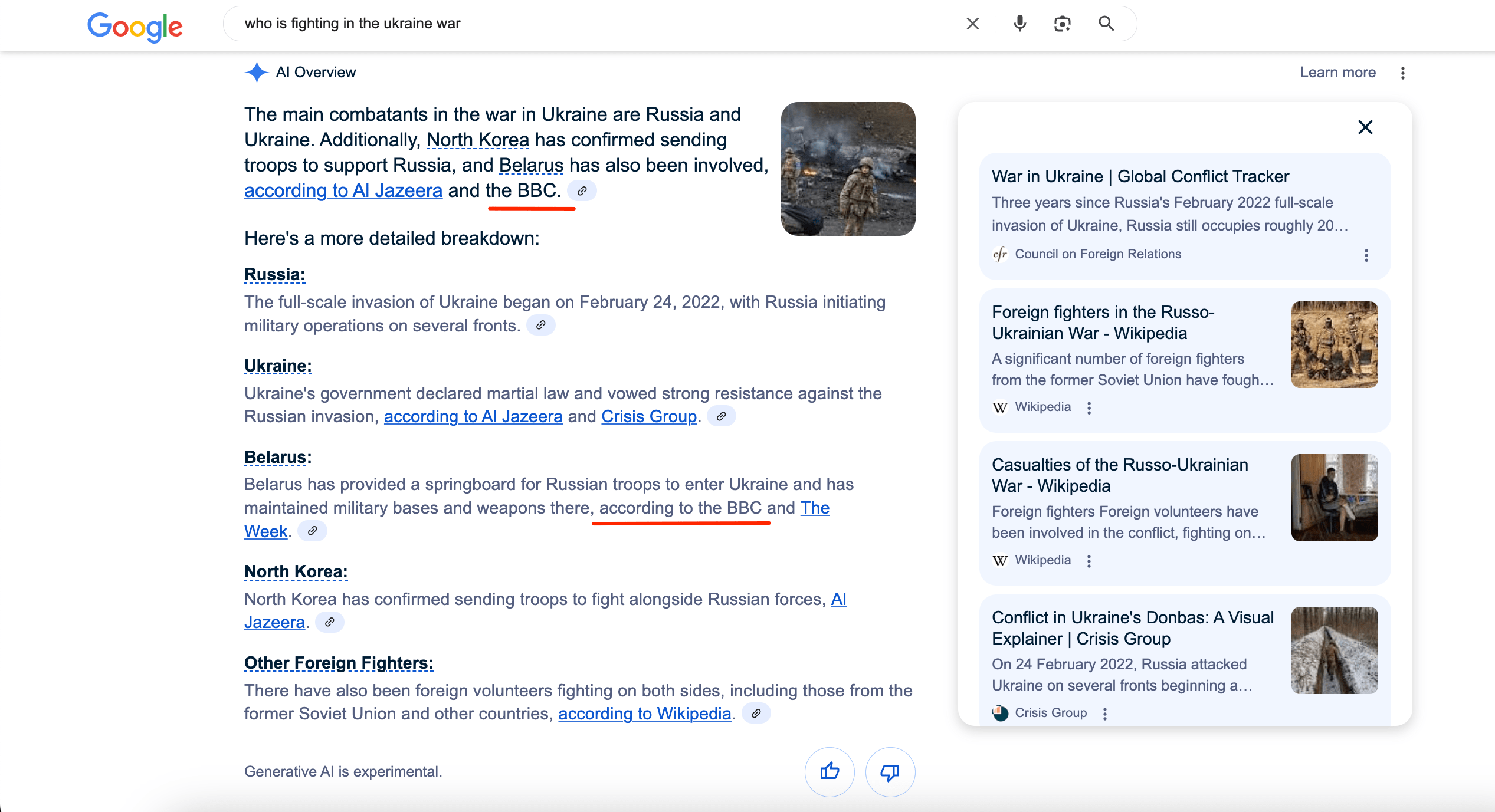
There are no direct links to the BBC in the AI response. But the underlying sources AIO draw from contain frequent links to the BBC:
- Council on Foreign Relations: 9 links to BBC.com
- Wikipedia – Foreign fighters in the Russo-Ukrainian War: 5+ links to BBC.com
- Wikipedia – Casualties of the Russo-Ukrainian War: 30+ links to BBC.com
- The Week: echoes the same themes and sources.
So, to increase brand mentions in AIOs, get backlinks from the sources they already cite for your target keywords. This is one of the greatest factors for improving your inclusion chances.
Now that we’ve explored how media sources are represented through links and text in AIOs, it’s equally important to examine how often AIOs explicitly attribute information to those media outlets. While AIOs often include clear phrases like “according to [source]” or “as reported by [source],” the consistency of this practice varies significantly by outlet.
We analyzed over 50 attribution patterns. And our main observation is that for at least half of the sources on our list, more than 50% of their brand mentions include explicit attribution.
Here are the highest rates of explicit attribution (share of brand mentions):
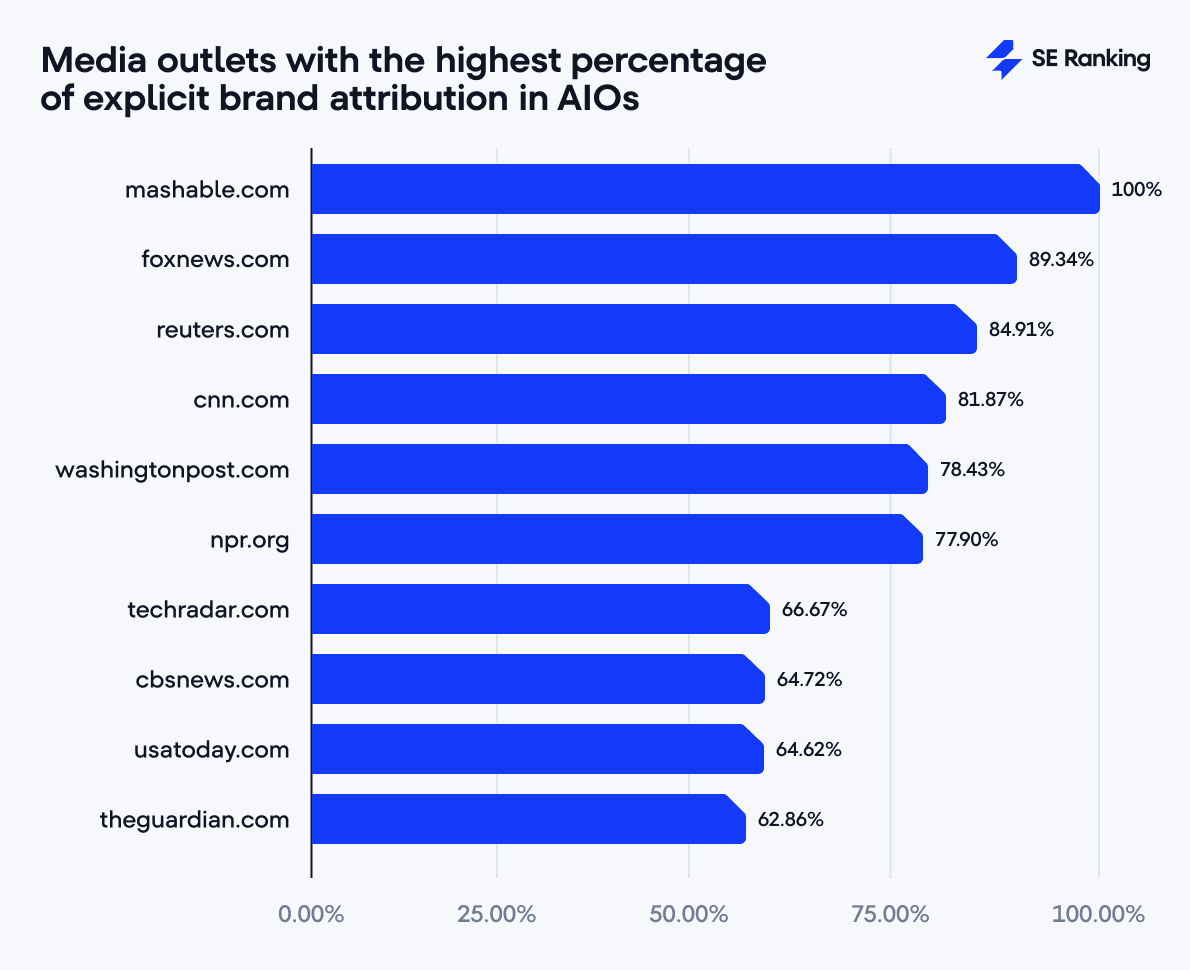
Note: With only three brand mentions in AIOs, Mashable’s data may not be representative and could skew the chart’s interpretation.
Below are the lowest rates of explicit attribution (share of brand mentions):
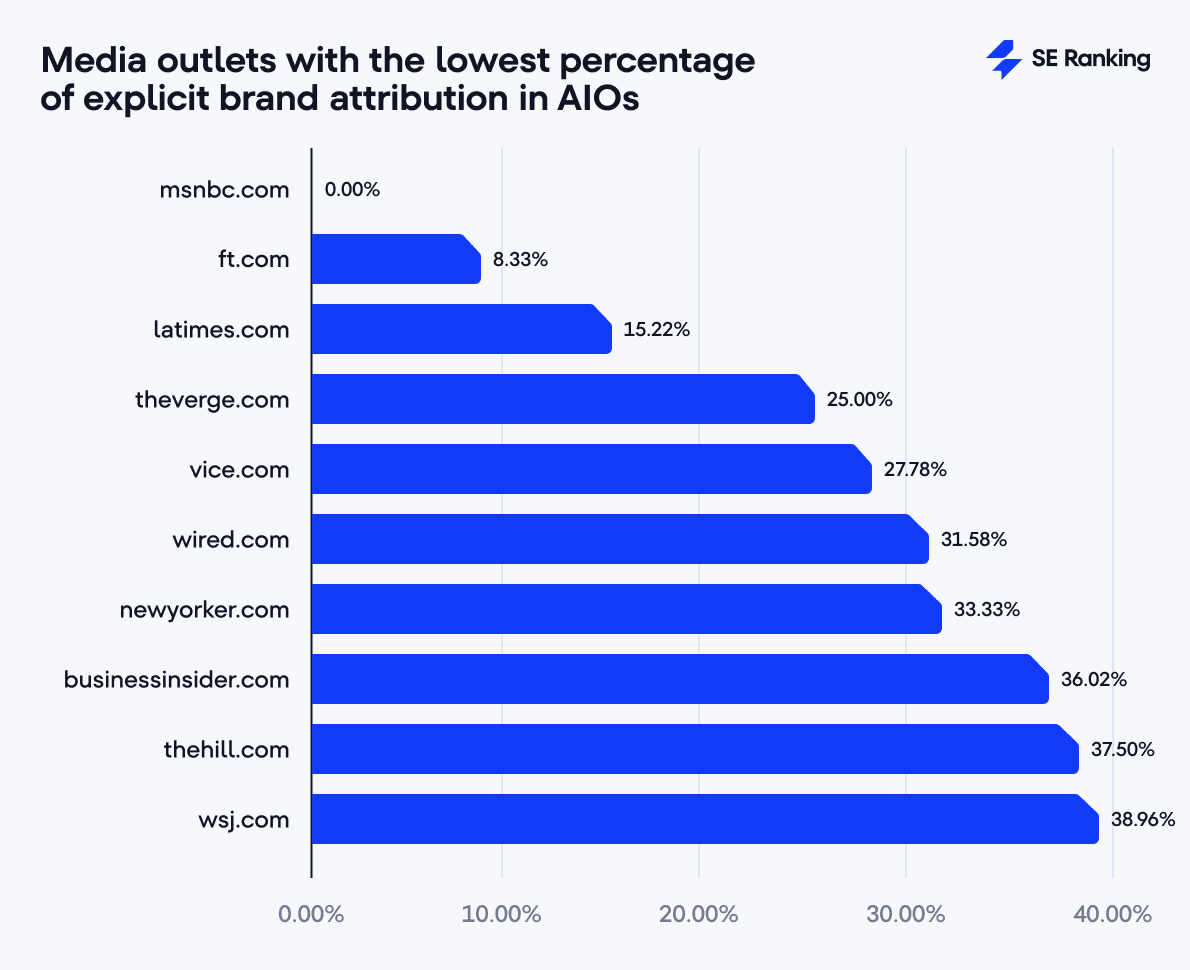
How do AIOs handle paywalled content of media outlets?
It’s no secret that Google bots have access to content behind paywalls and can process it, but the media industry is more concerned about something else: does Google provide users with free access to paid content? If so, does it include brand mentions alongside such content?
This is how Google answers the question:
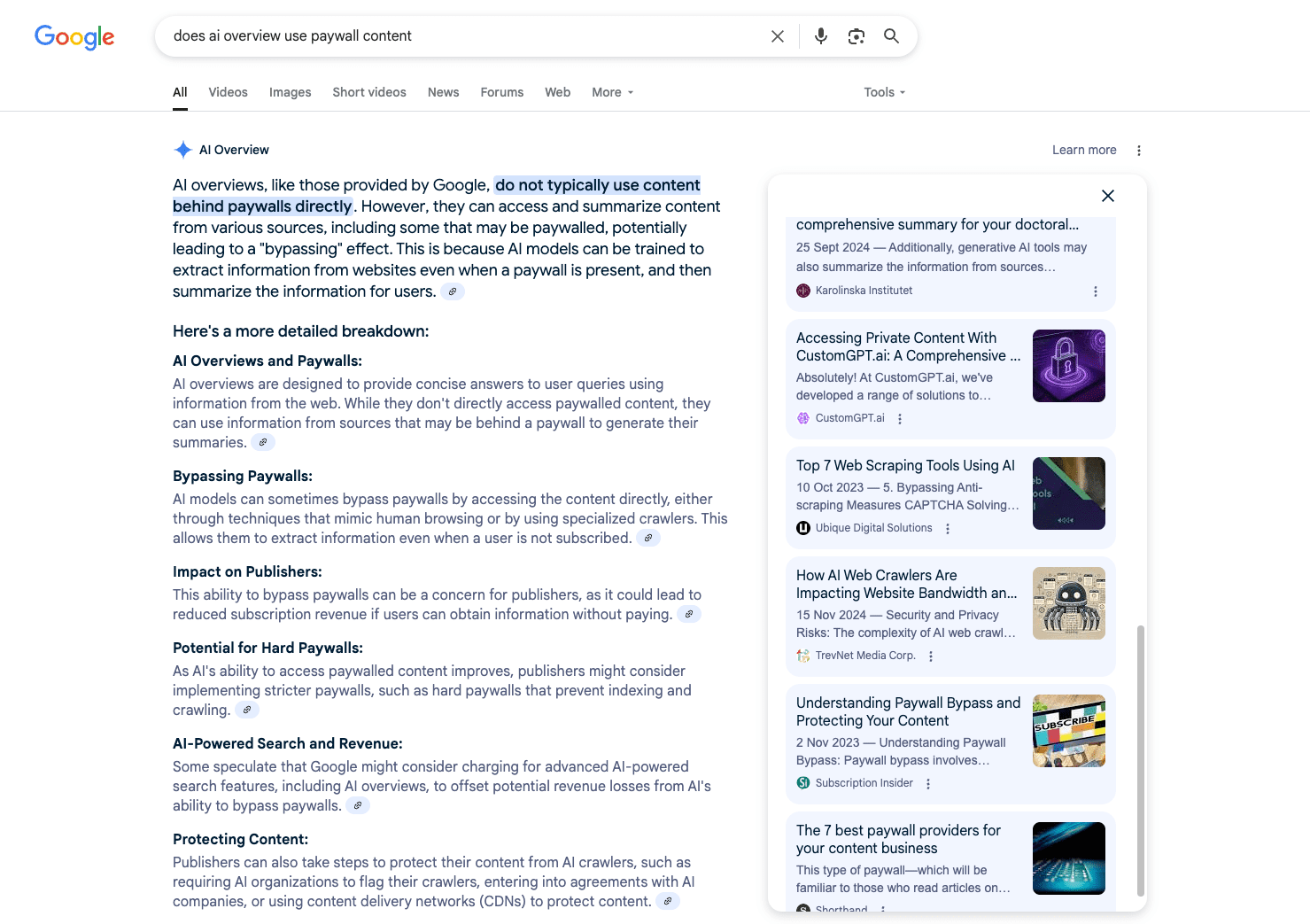
Last year, this issue sparked considerable concern among journalists and authors, who feared their work was misappropriated. For instance, Reece Rogers published an article on Wired titled “Google’s AI Overview Search Results Copied My Original Work”, where he detailed an instance of encountering a fragment from his own article within the AIO.
Methodology
Given the size of our dataset, we selected a random sample of 3,404 AIO responses — 21.61% of the total 15,750 AIOs featuring media outlets with links to paywalled content — and analyzed how this content was used.
We compared AI-generated responses to the original articles, breaking both into sequences of words. Particularly, we focused on detecting segments of five or more consecutive words that appeared identically in both texts.
- Notable copying phrases (5+ words): the total number of copied phrases with five or more words. This gives a general idea of how often content is reused, including both short and long copied phrases.
- Critical copying phrases (long verbatim segments of 10+ words): the number of longer copied phrases with 10 or more words. These are strong signs of intentional copying because it’s very unlikely for 10 words in a row to match by accident.
We also distinguished between two primary modes of reuse:
- Verbatim copying: direct, unchanged replications of text from the source.
- Modified copying: slight alterations, such as synonym substitutions or structural tweaks, that preserve the original’s meaning and sequence.
Note: While our method is effective at catching textual reuse, it cannot detect copying of ideas conveyed through completely rephrased or paraphrased expressions.
Key findings from the analysis
Here are our findings based on 3,404 responses analyzed:
Total Number
2,343
Percentage
69%
Total Number
66
Percentage
2%
2,343
69%
66
2%
- The majority of AIOs contained duplicate segments, either verbatim or slightly modified.
- Only 15% of responses with identical long fragments of 10+ words included any form of attribution.
- 6,335 segments were categorized as modified copying, accounting for the majority (87%).
- 975 segments were identified as verbatim copying – about 13% of total duplicate segments.
- On average, each response containing duplication included approximately three borrowed segments.
Note: We didn’t analyze every link mentioned by AIOs in these responses, but we observed focus sites only. This means that each response may contain more duplicates than reflected in our analysis.
Real-world examples
- Long verbatim segments (10+ words)
While long verbatim duplication was found in only 66 responses (~2% of the dataset), these cases are particularly noteworthy. They signal instances where the AIO replicated substantial portions of the original text, leaving little room for interpretation.
Example: Nobel Prize winners in economics and their works
Google generated this AIO for the query:
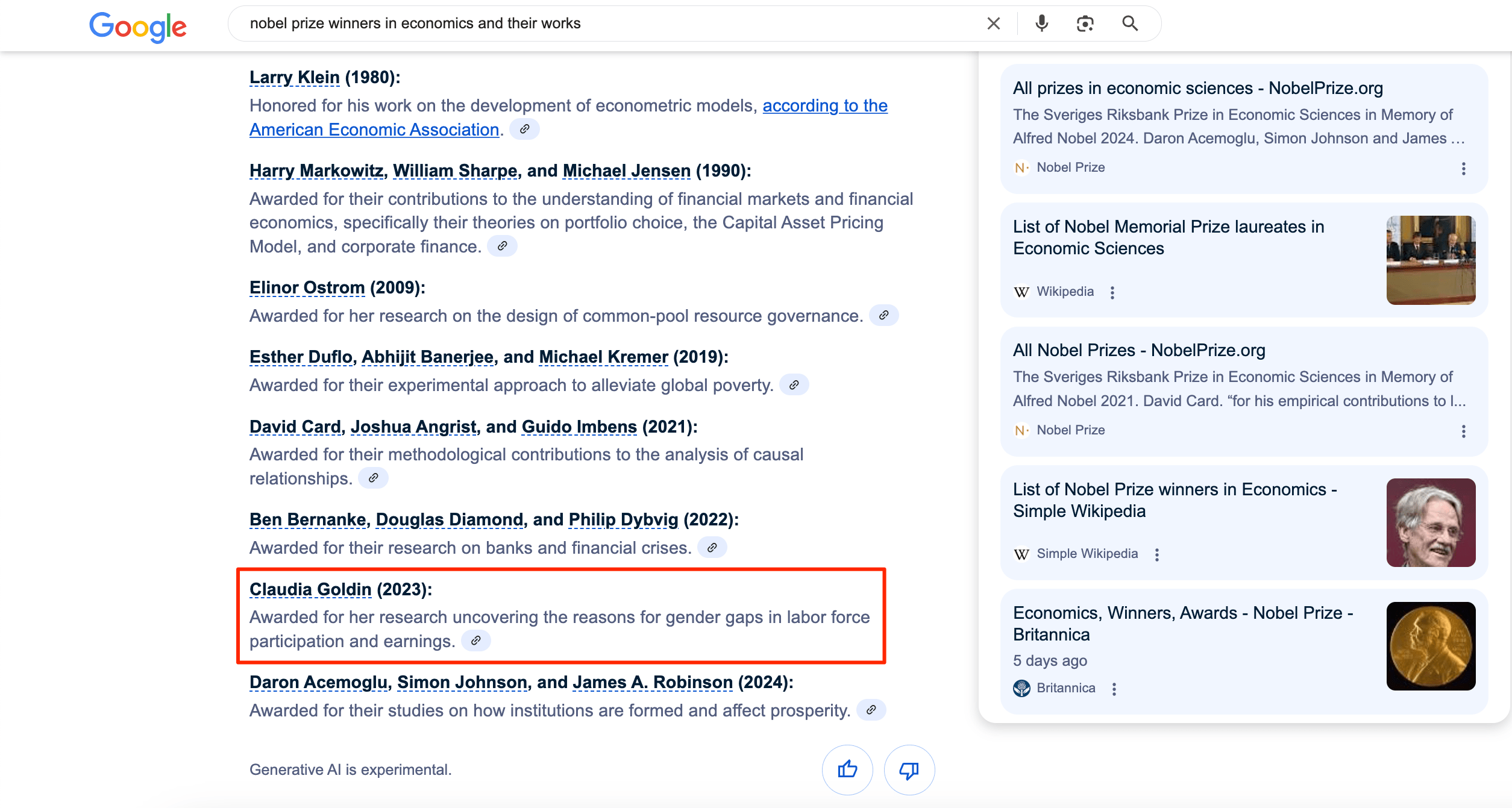
And here’s the original segment from the New York Times article:
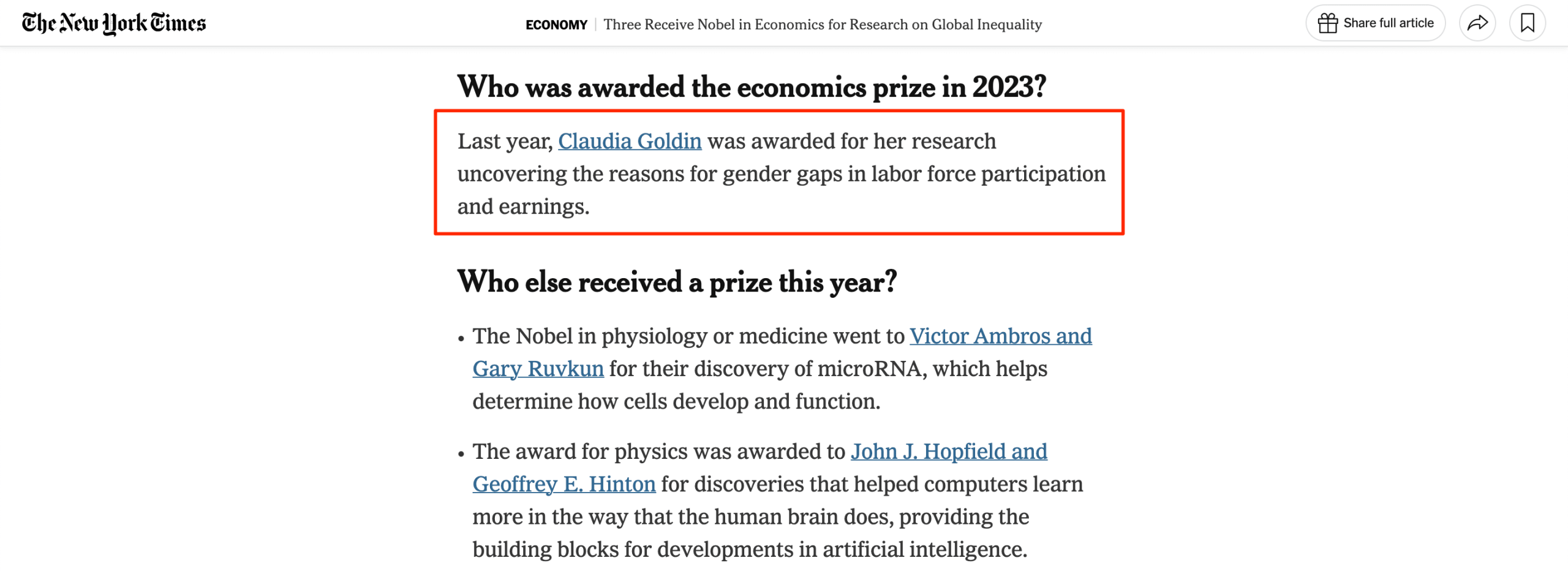
This AIO mirrors the original article almost exactly, with only minor adjustments to formatting.
Example: Texas Abortion Law Supreme Court 2021
Here’s the AIO’s rendition of the segment:
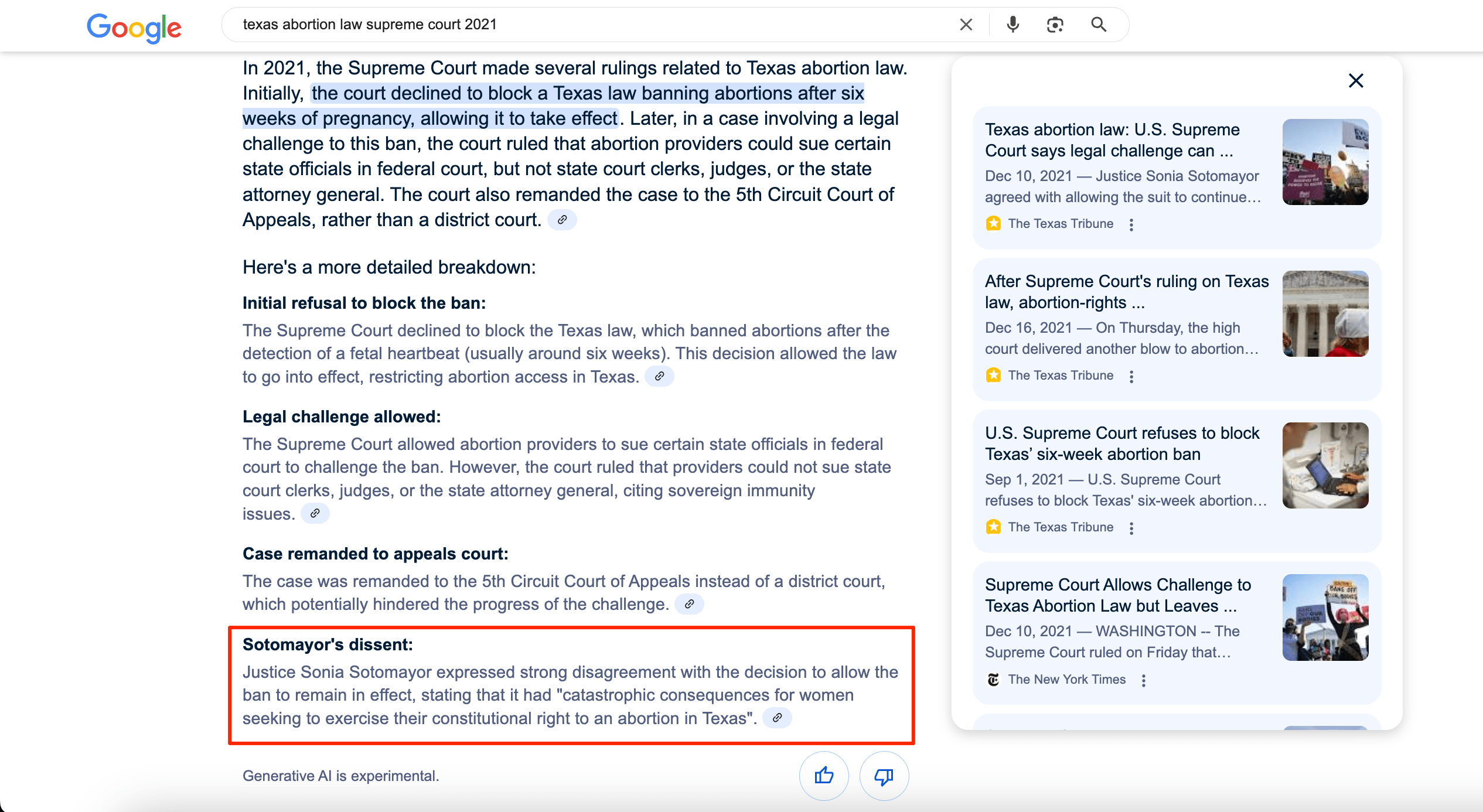
Now, let’s look at this section from the New York Times post:

Once again, the AIO’s phrasing is almost identical to the original source. All it does is restate the key point.
Example: Сurrent updates on US Angel investing
The AIO for this query includes the following fragment:
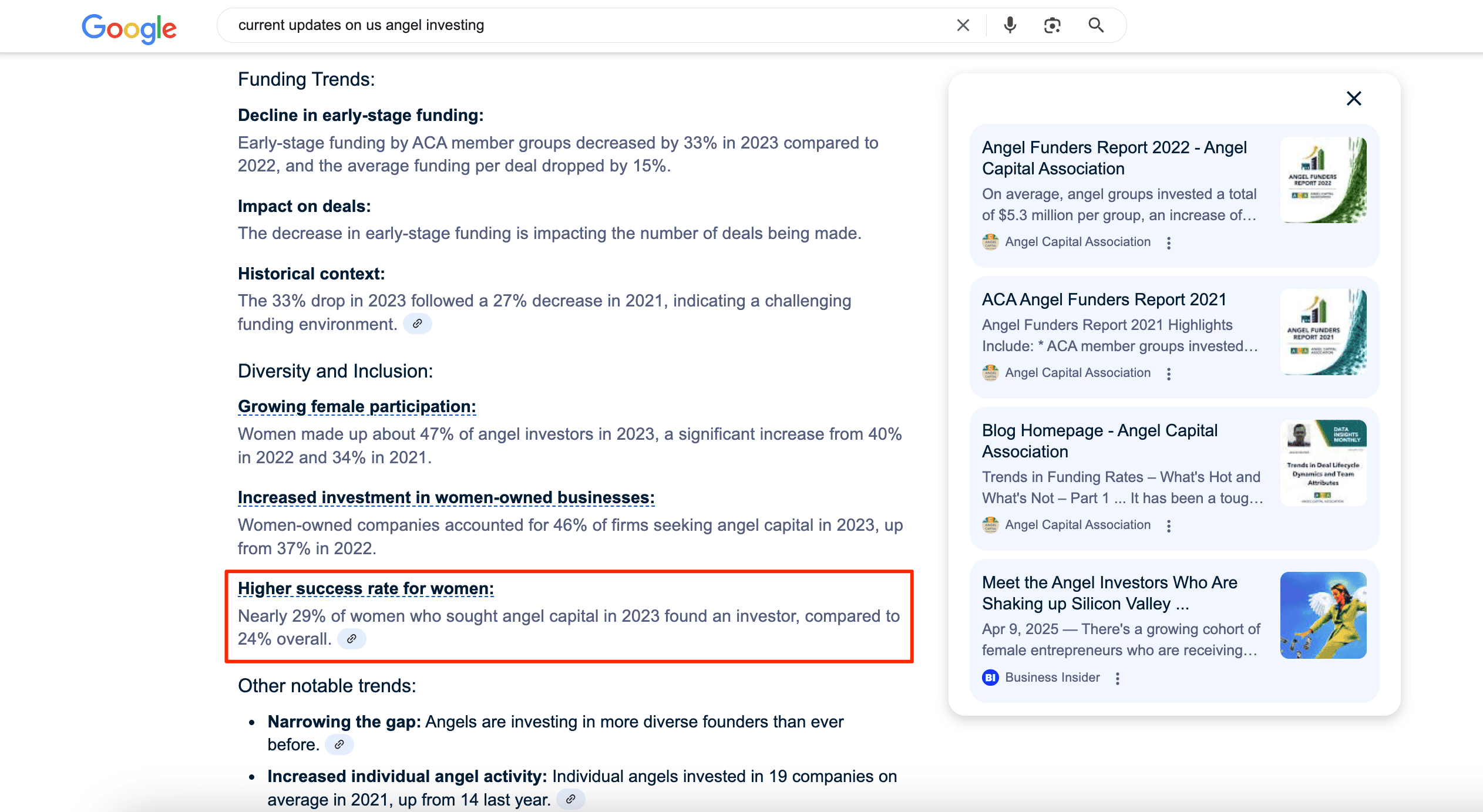
And here’s the original content section from Business Insider:
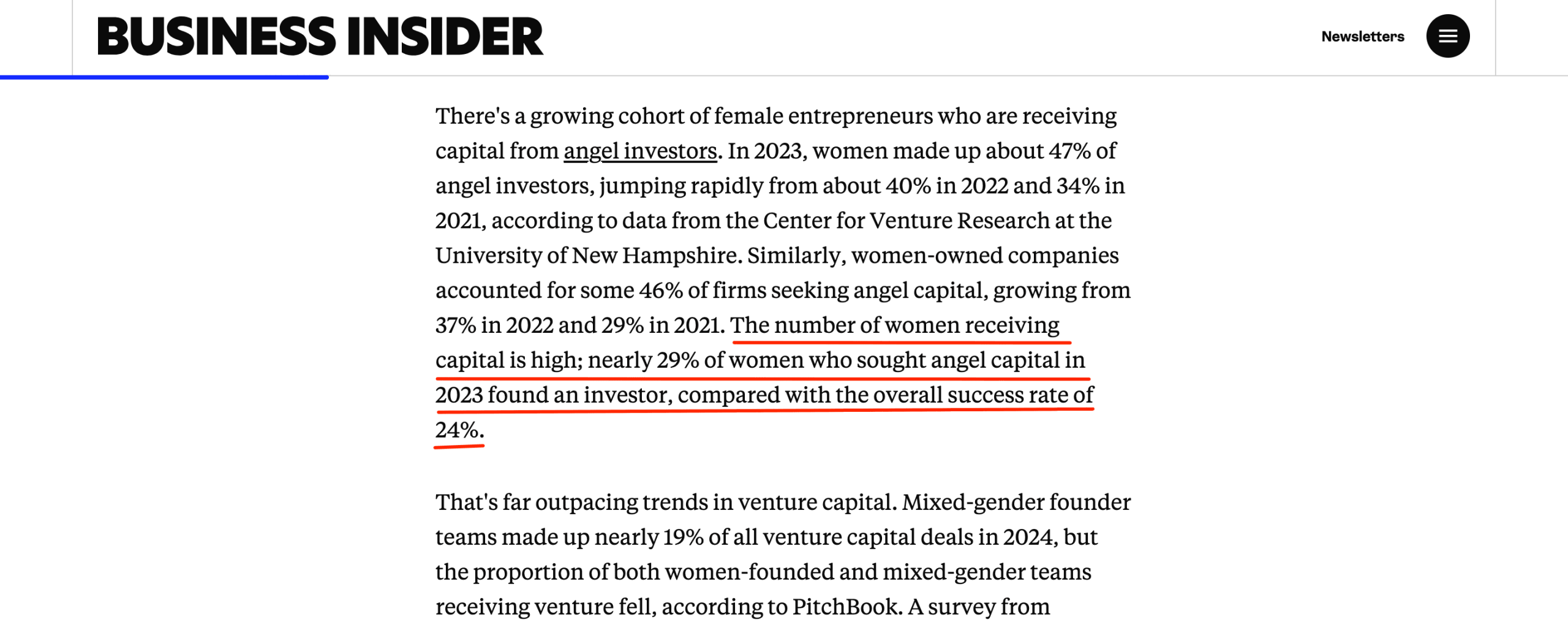
The AIO version barely diverges from the original’s wording. It also uses 2023 data, even though newer articles on this topic are present in search results.
- Duplicate fragments with attribution
Although some responses with long segments do include brand attribution, this is the exception and not the rule: only 10 out of 66 responses with long verbatim segments (10+ words) provided clear attribution, which is just 15%.
Here’s an example of AIO with a brand attribution for the search query current air quality improvement efforts in America:
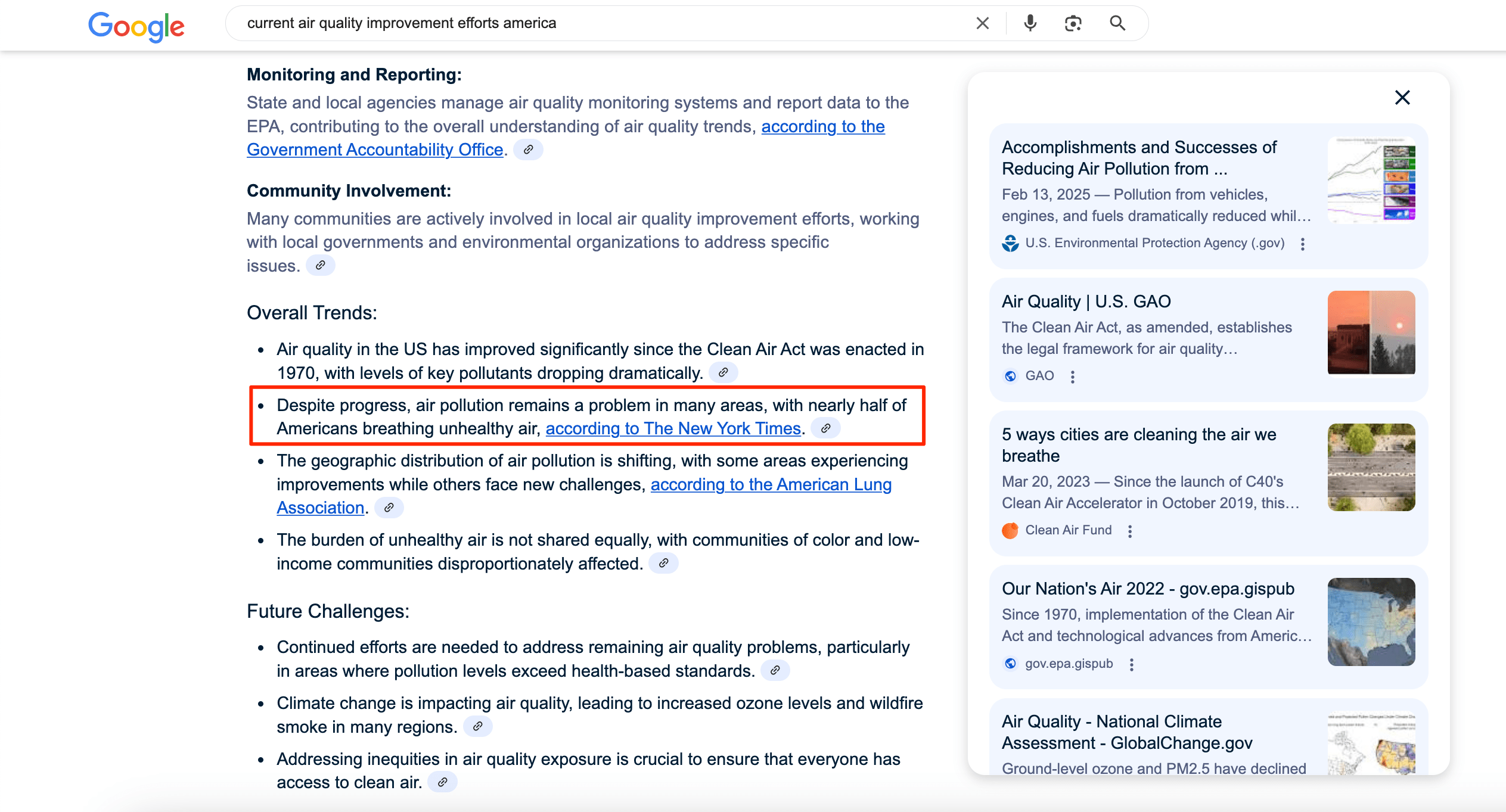
In contrast, here’s the AIO for the keyword Wells Fargo lawsuit opening accounts, which consists of 22 words from the NYT article without attribution:
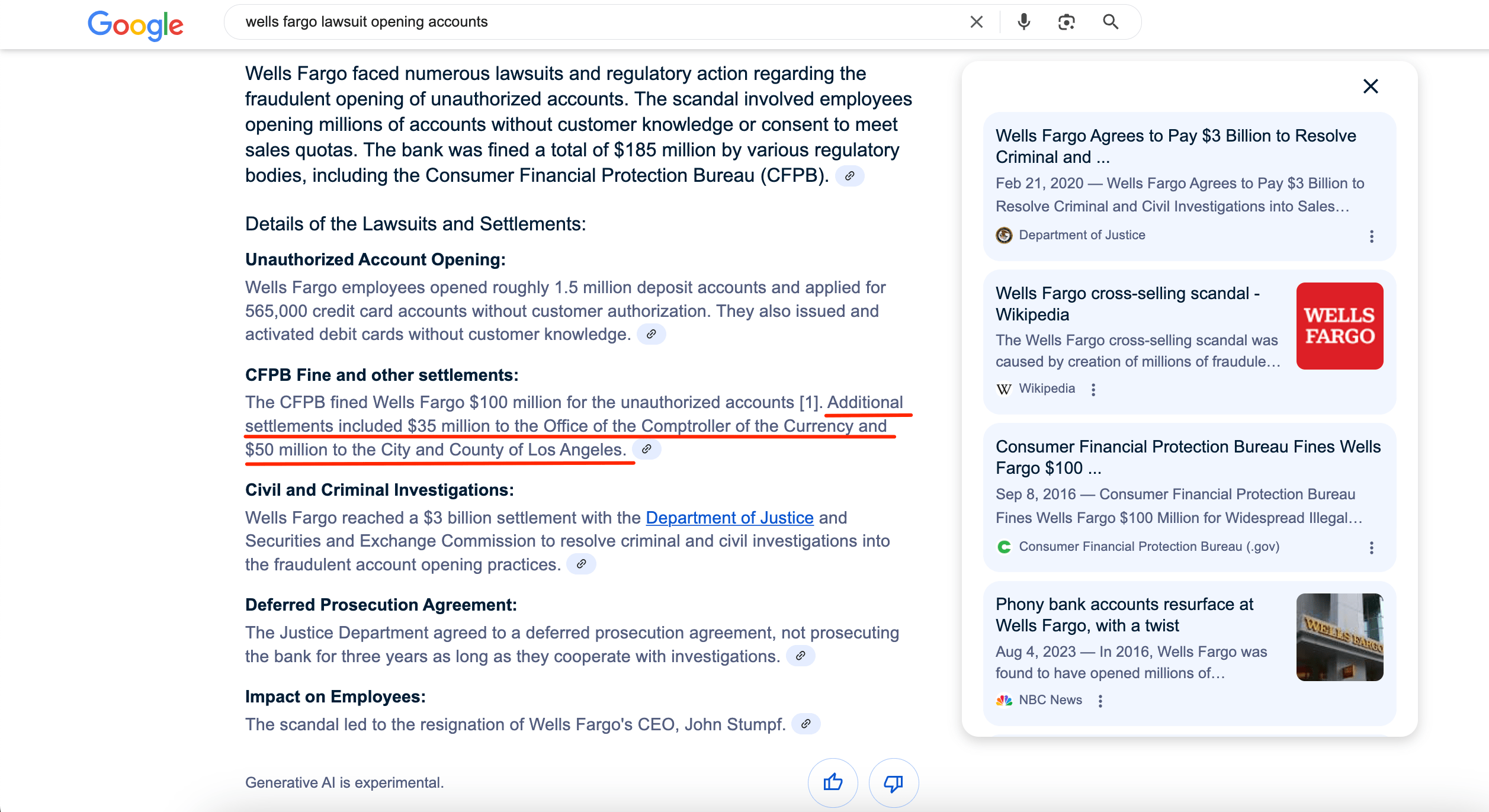
Here’s the content segment taken from the original article:

- Partial quotations and contextual paraphrasing
We found 6,335 instances where the AIO made only small changes to the original text and looked very similar to the source.
To put that in perspective, we analyzed 3,404 responses and found that 2,343 of them had copied fragments. This means that, on average, each of these responses included about three reused pieces of text.
AIOs typically combine several of these short fragments to create a complete answer. Most matches in our study were pretty short (5–8 words), but there were some longer ones too.
Example: P Diddy controversy sparks widespread public debate
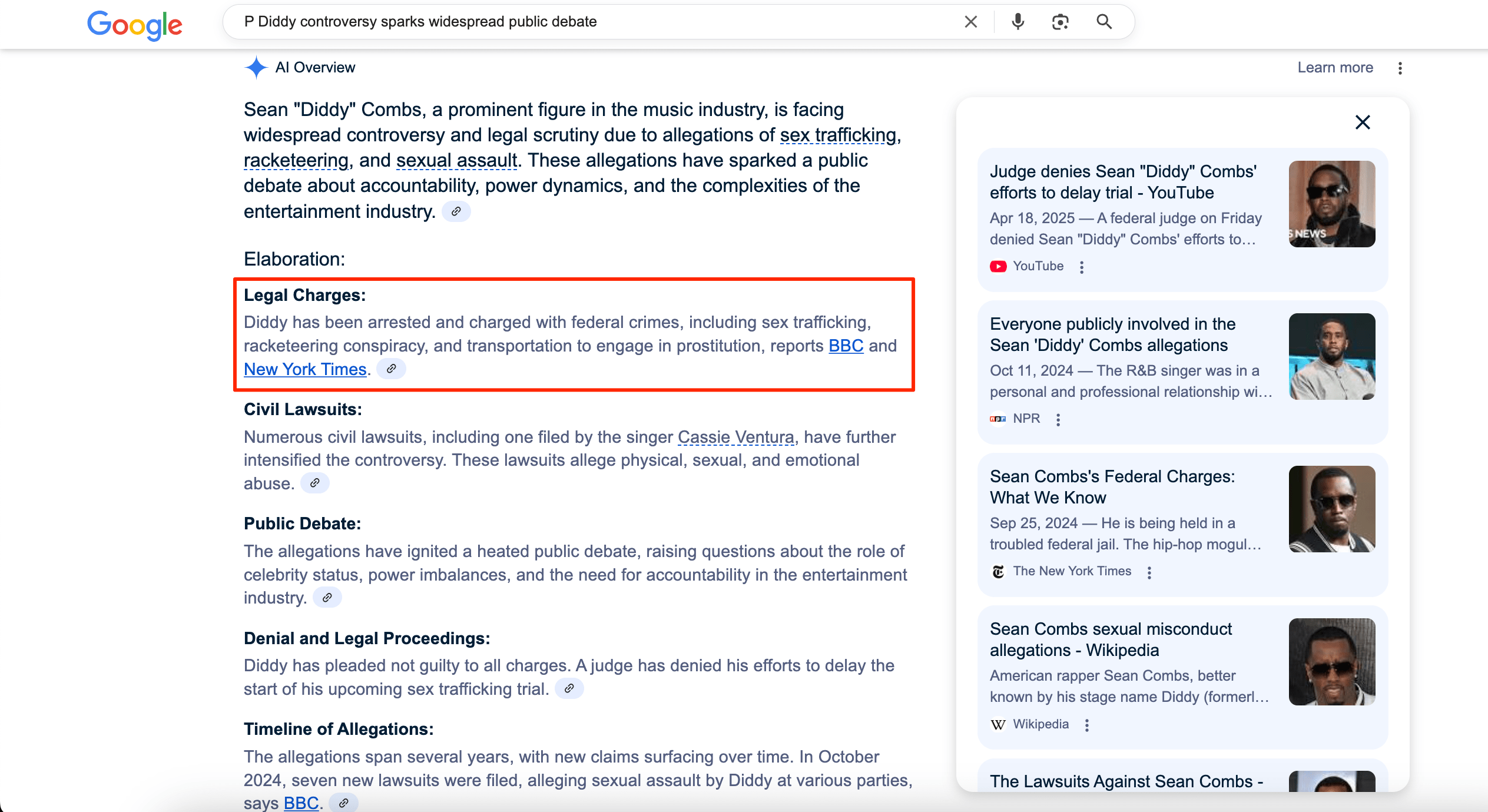
Here’s the NYT article where the content is likely taken from:

On top of that, AIOs often employ synonym replacement or minor rewording to present information that mirrors the source but avoids verbatim duplication.
Example: What time is the Grammy Awards
Take a look at the AIO fragment for this search query:
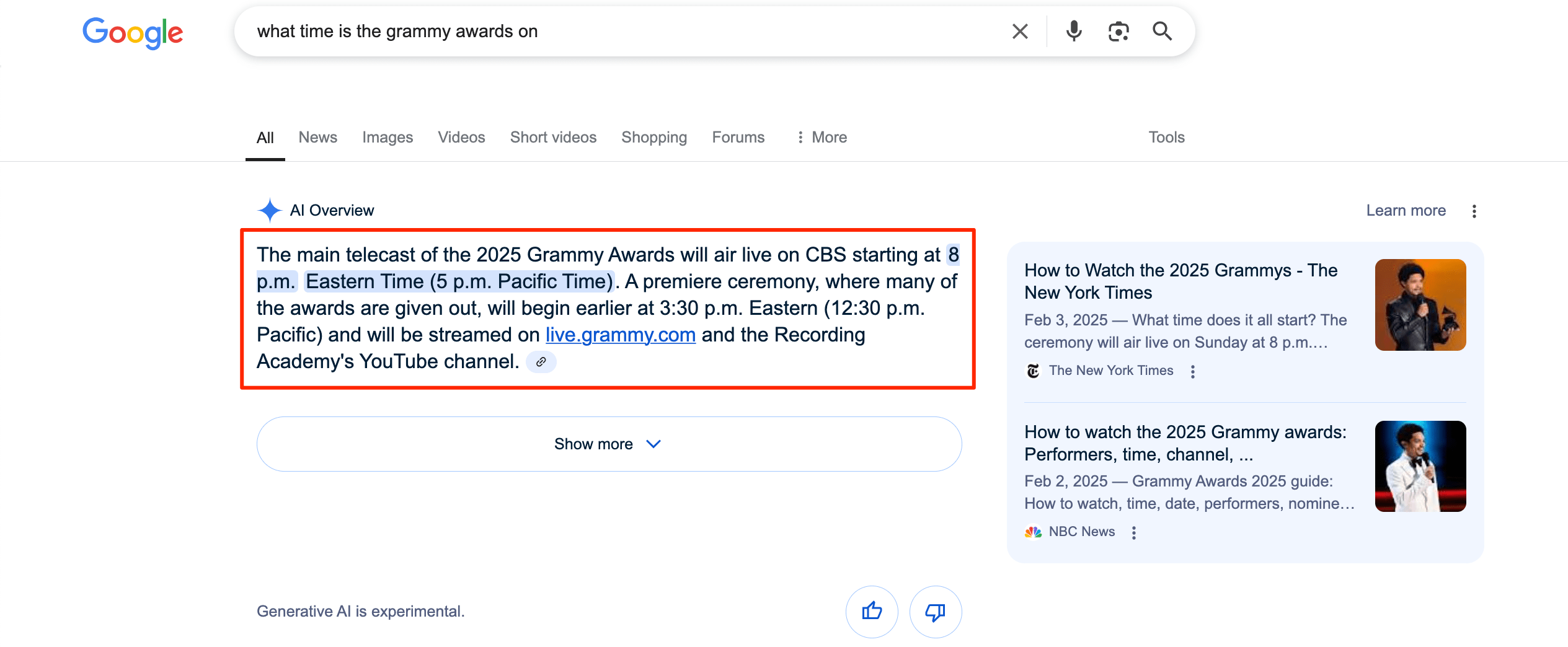
And here’s the NYT fragment:
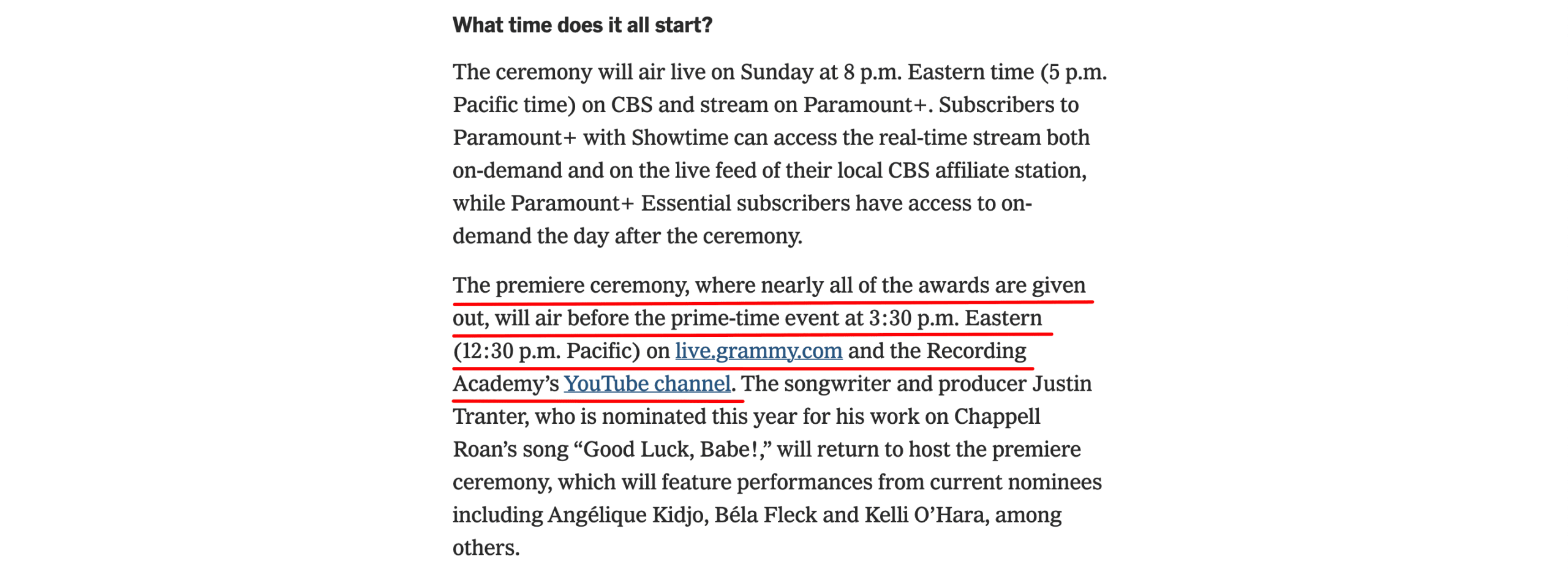
This example clearly illustrates how Google’s AIOs often employ synonym substitution or slight simplifications, like changing “nearly all of the awards” to “many of the awards” and swapping “will air before the prime-time event” for “will begin earlier.”
Comparison of paywall vs. non-paywall content
We also looked at how AIOs behave with free content versus paywall content. We took a random sample of 3,243 AIO responses that referenced free content. Here’s the breakdown:
- Total analyzed responses: 3,243
- Responses with duplicate fragments: 2,480 (76.47% compared to 68.8% for paywalled content)
- Verbatim copying segments: 1,404 vs. 975 for paywalled content
- Text modified segments: 6,303 vs. 6,335 for paywalled content
- Segments with attribution: 27 vs. 10 for paywalled content
18% of these duplicate fragments were verbatim copies, which is 5% higher than what we observed in AIO responses referencing paywalled articles.
Despite a lower total sample size compared to paywalled content, the number of long verbatim segments (10+ words) was higher in this free content dataset: 108 vs. 66 for paywalled content. That’s a 61% increase in long verbatim copying compared to paywalled content.
Example: What do we know about climate change
Here’s the AIO fragment:
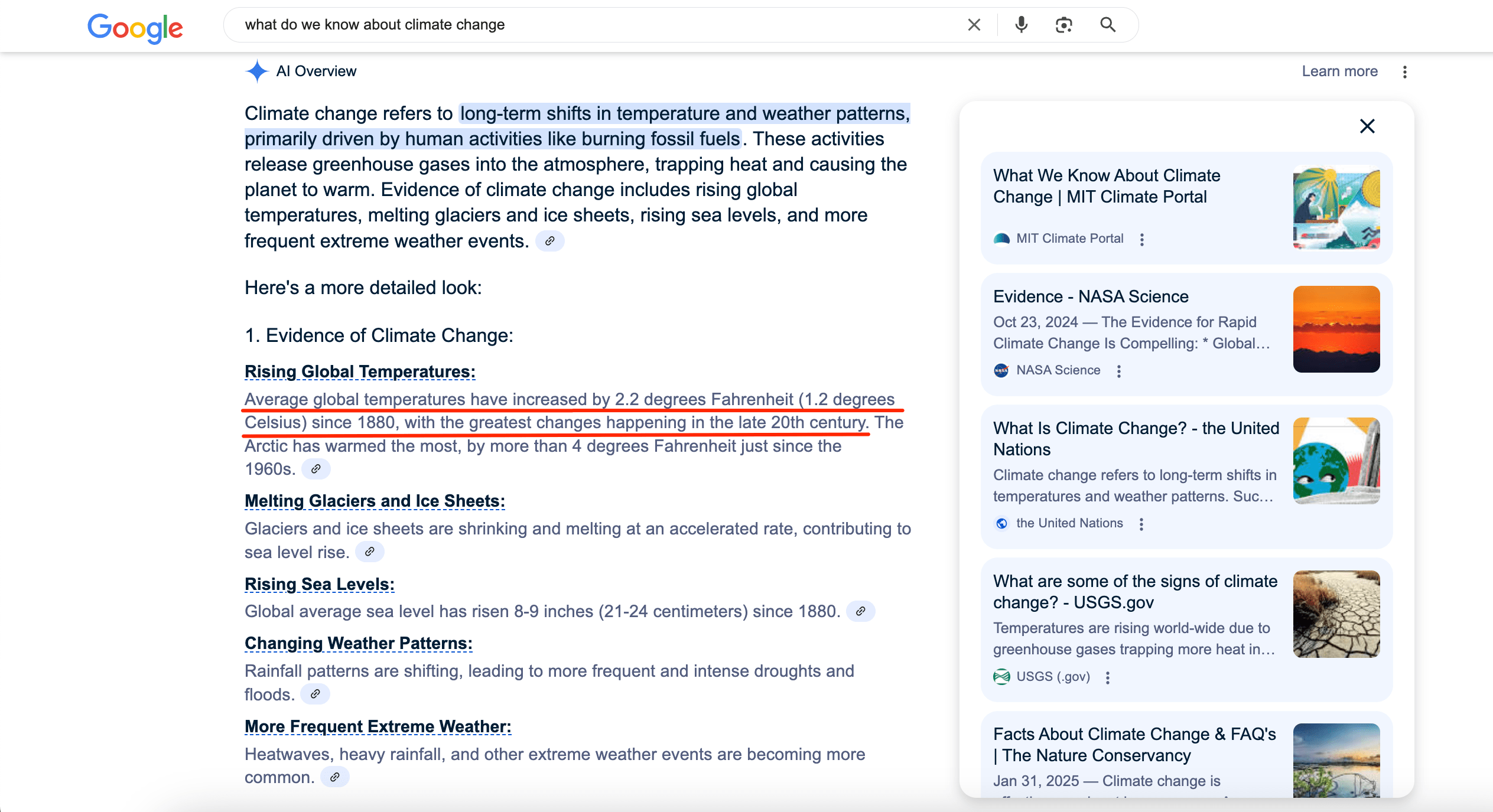
And here’s the part from the NYT article:

The AIO features the exact same sentence as the original source.
Here’s another interesting case with the AIO for the keyword what consequences will Diddy face legally. The response is 176 words long, with 73 words sourced from NBC News. Of those, 32 words were taken directly from verbatim fragments.
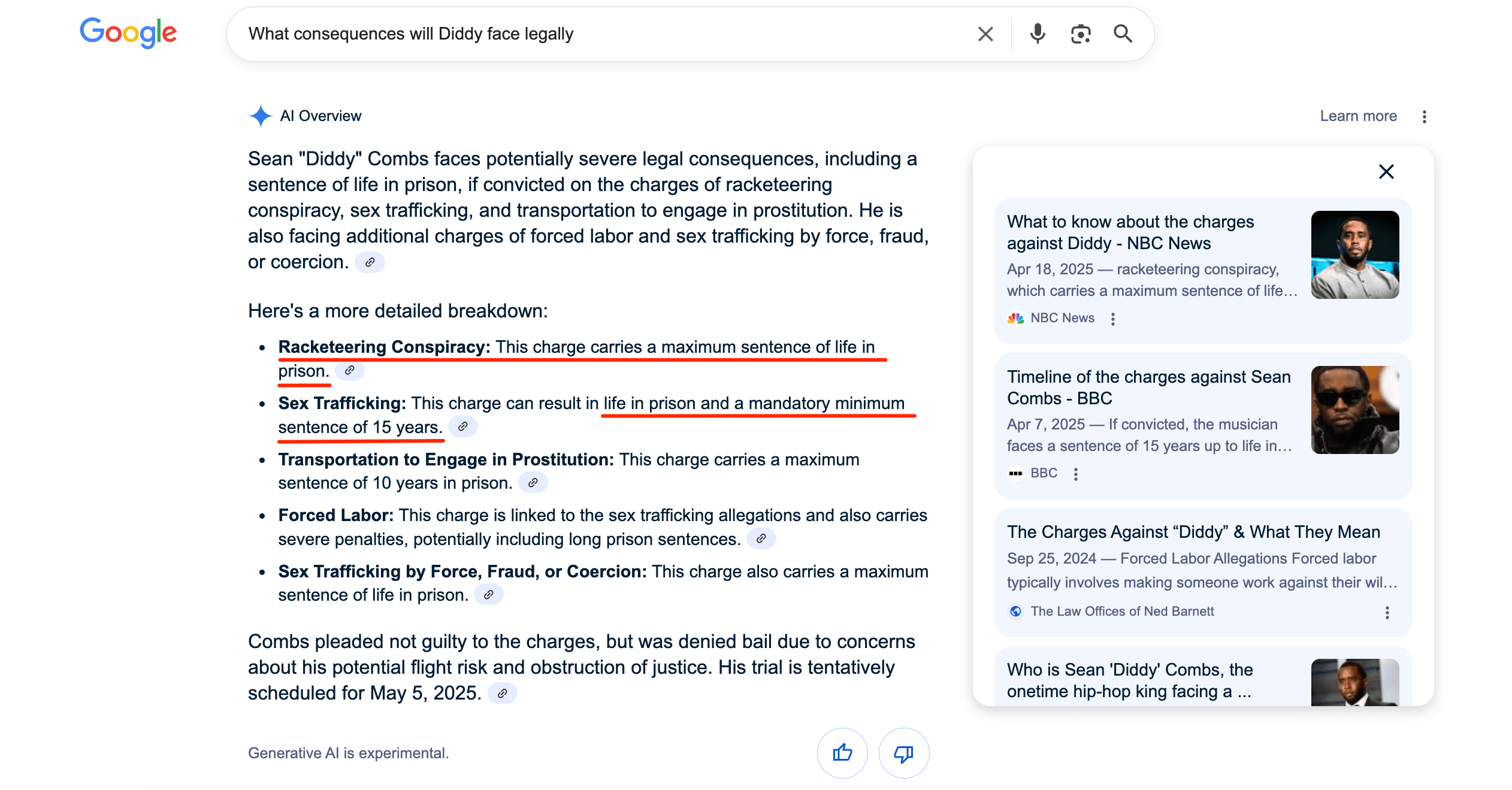
Compare it to the wording in the original NBC News article:
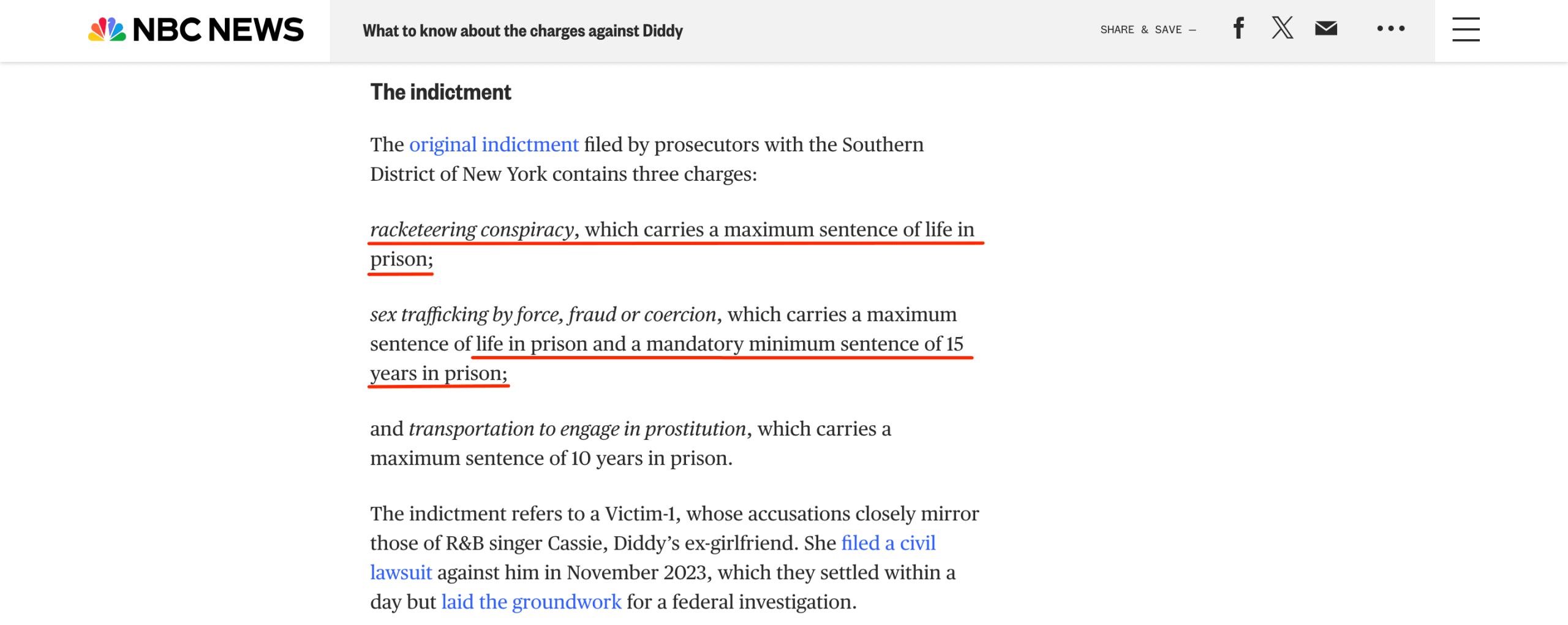
We also found twice as many long verbatim segments of 15 words or more in the free content sample. It was 20 instances compared to just 10 in the paywalled content.
Example: Polygamy in the America today
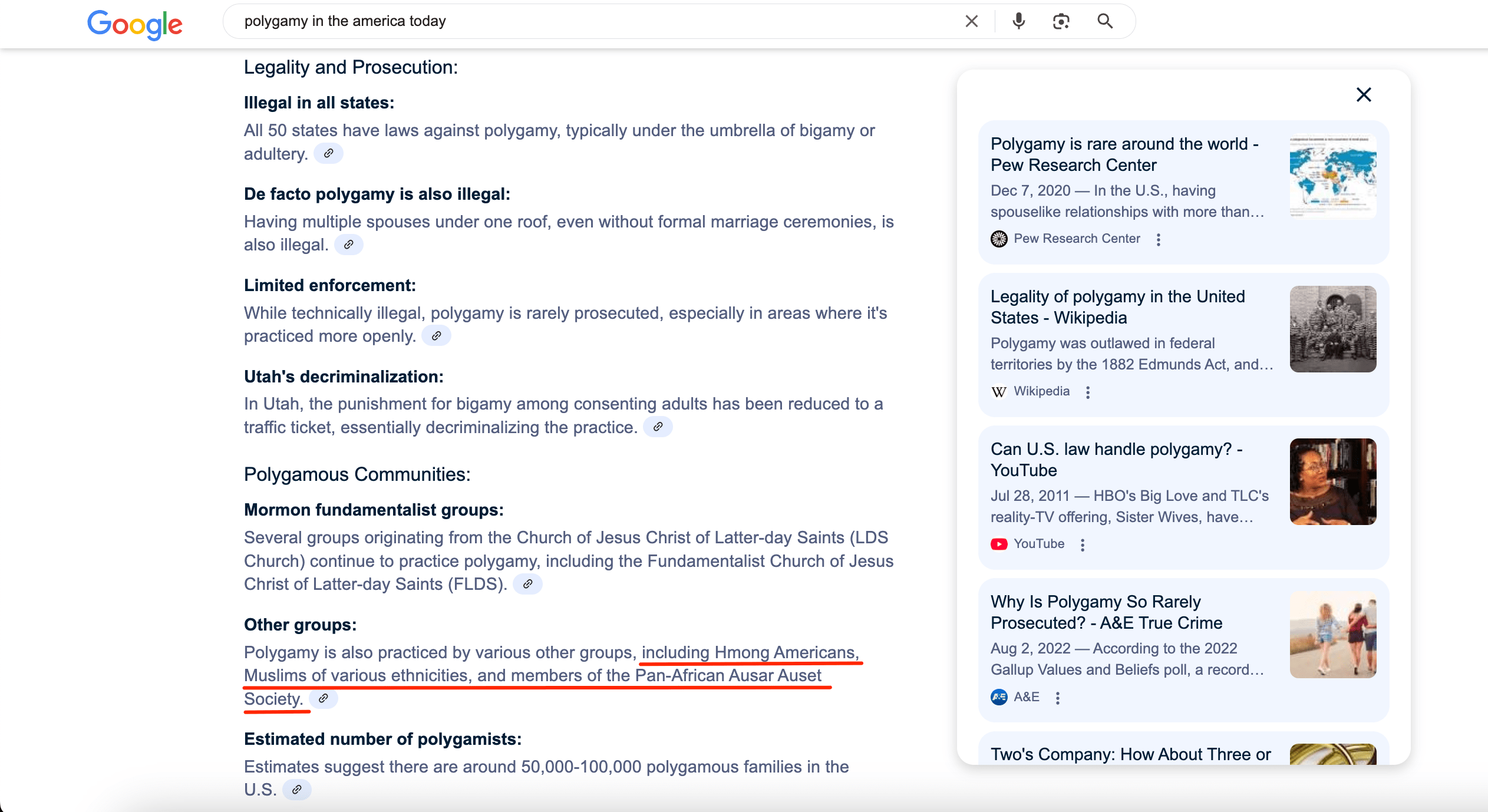
And here’s the same sentence piece from The New Yorker article:

And here is one more example with a long verbatim segment for the keyword current news on Keystone Pipeline:
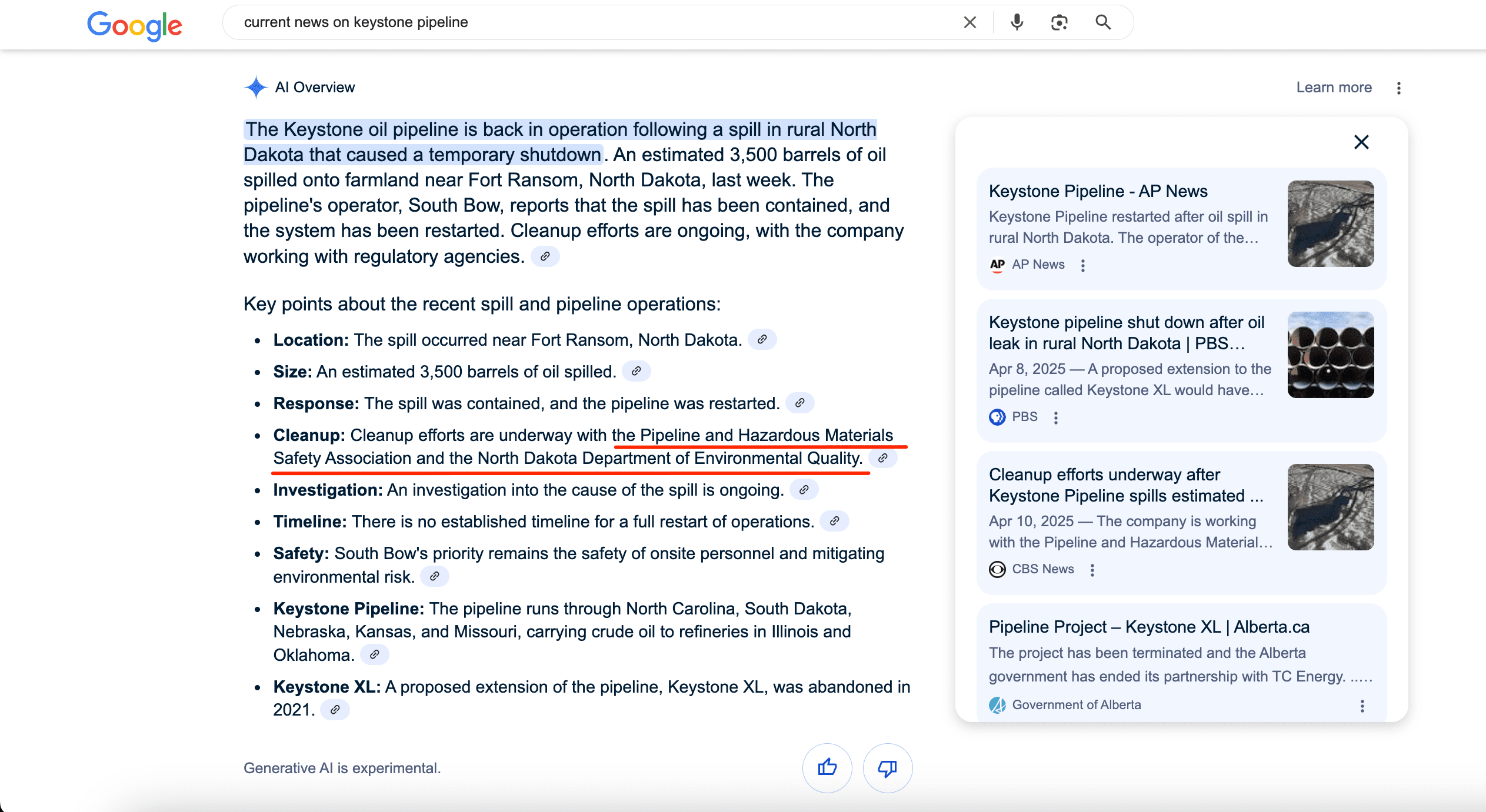
You can find the same content excerpt from a CBS News article:
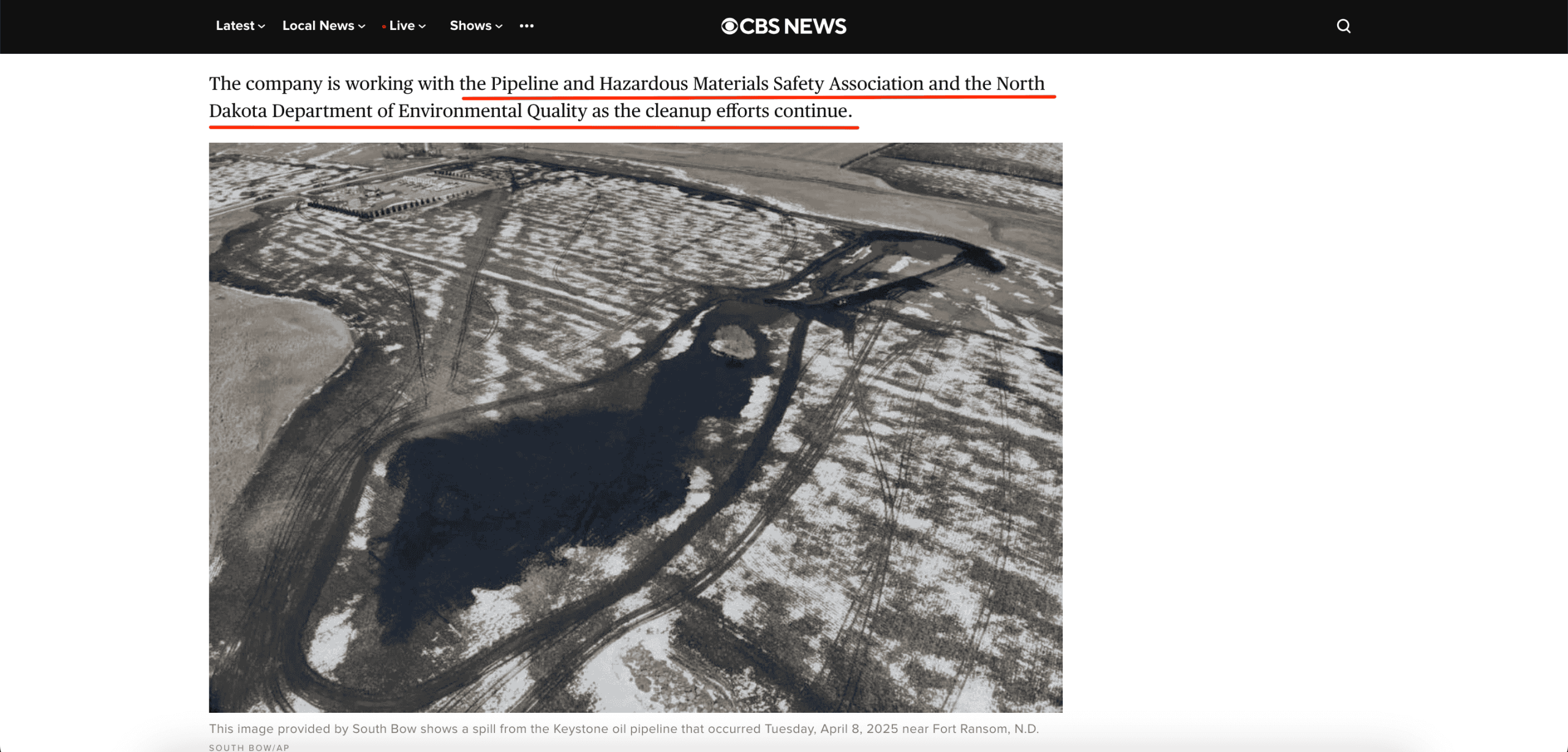
The analysis revealed that Google’s AIOs use a similar approach when referencing both paid and open resources. The model extracts text fragments from articles (sometimes copied exactly, other times slightly changed), and generally does so without mentioning the original brand directly, though it sometimes includes a link to the source. While only a small percentage of responses (2–3%) contained long copied passages, the analysis identified over 15,000 matching phrases (five words or more) across approximately 5,000 responses.
How AIOs, AI Mode, and ChatGPT Search handle content citations and present info from paid sources
The debate around AI-generated content and the use of copyrighted materials is both complex and contentious. On one hand, features like AIOs are designed to generate concise summaries, so it makes sense that they pull from different sources. On the other hand, content creators argue that AI companies are using copyrighted content without proper authorization, credit, or compensation.
Several high-profile lawsuits have emerged against major players like Google, OpenAI, and Perplexity, challenging how these systems access, process, and repurpose journalistic content.
A particularly notable case involves a coalition of prominent news organizations, led by The New York Times, which has consolidated three separate lawsuits against OpenAI and Microsoft into one federal case. The lawsuit claims that OpenAI systematically copied millions of copyrighted articles, without permission or payment, to train ChatGPT.
Google has also been involved in a significant legal challenge, this time from educational technology company Chegg. Chegg’s lawsuit alleges that Google’s AIOs undermine digital publishing by using publishers’ content to keep users on Google’s platform. The introduction of AIOs has reportedly led to measurable declines in website traffic and subscriber numbers for Chegg, which led the company to consider sale or privatization options.
In Canada, five major news outlets have filed a lawsuit against OpenAI in Ontario’s Superior Court of Justice. The language in this case is particularly strong, accusing OpenAI of “brazenly misappropriating the News Media Companies’ valuable intellectual property and converting it for its own uses, including commercial uses, without consent or consideration.”
These lawsuits represent just a fraction of the legal challenges against AI systems. To explore how AI platforms handle content ownership and transparency, we conducted a test using five keywords across AIOs, ChatGPT Search, and AI Mode in Google. Here’s what we observed:
- ChatGPT Search: When a paragraph clearly derives from a specific source, a clickable citation appears next to it. Hovering over the source name highlights the relevant text. However, when a paragraph is generated from multiple sources, no citation appears next to the text itself, though a link to the source is provided in a list. The sources list is divided into “Citations” and “More.”
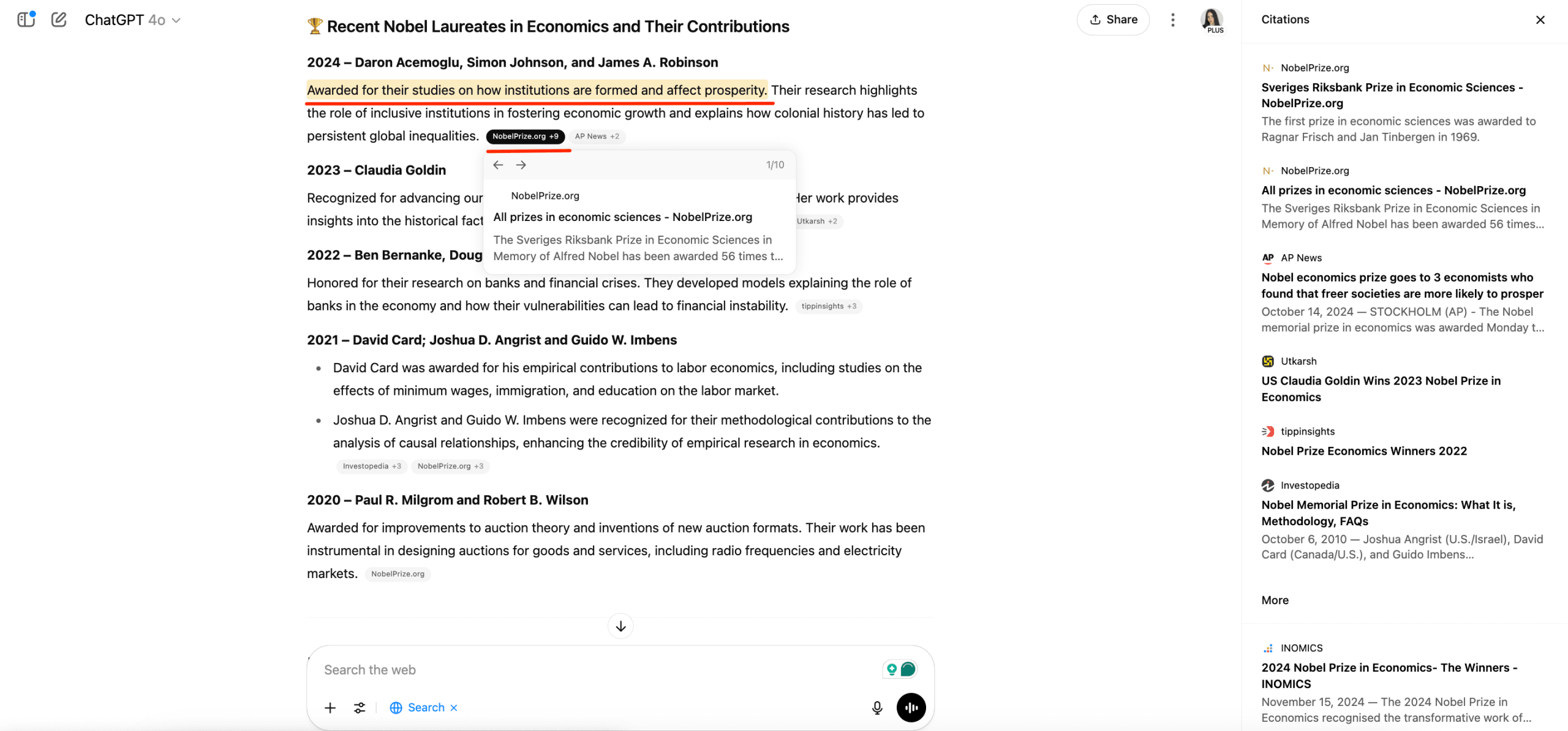
- AIOs: Similar to ChatGPT, AIOs add a checkmark next to the paragraph. Hovering over a paragraph reveals a list of the sources it draws from. Unlike ChatGPT, AIOs assign specific sources (or multiple sources) to each paragraph.
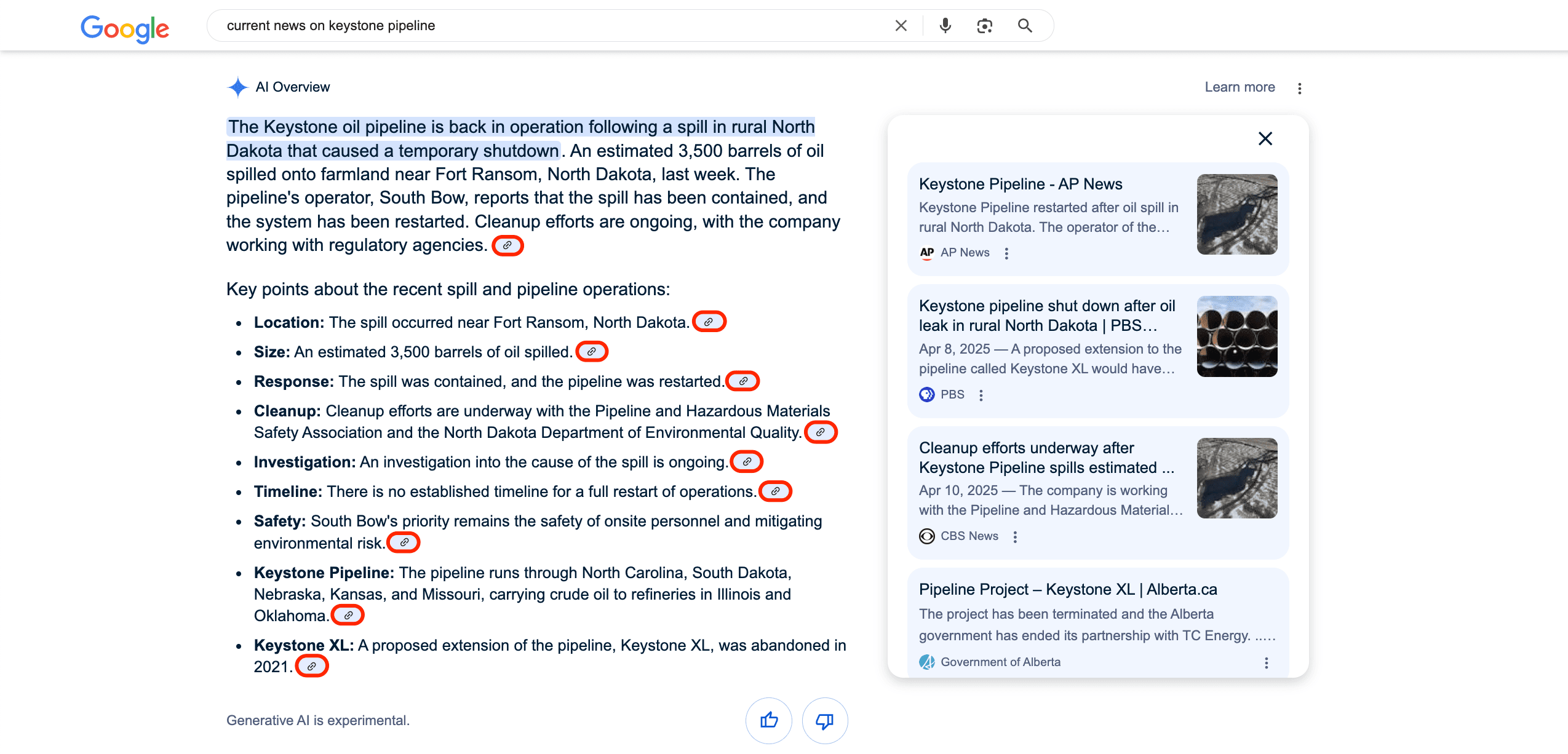
- AI Mode: This system operates similarly to AIOs but assigns sources at the section level over individual paragraphs.
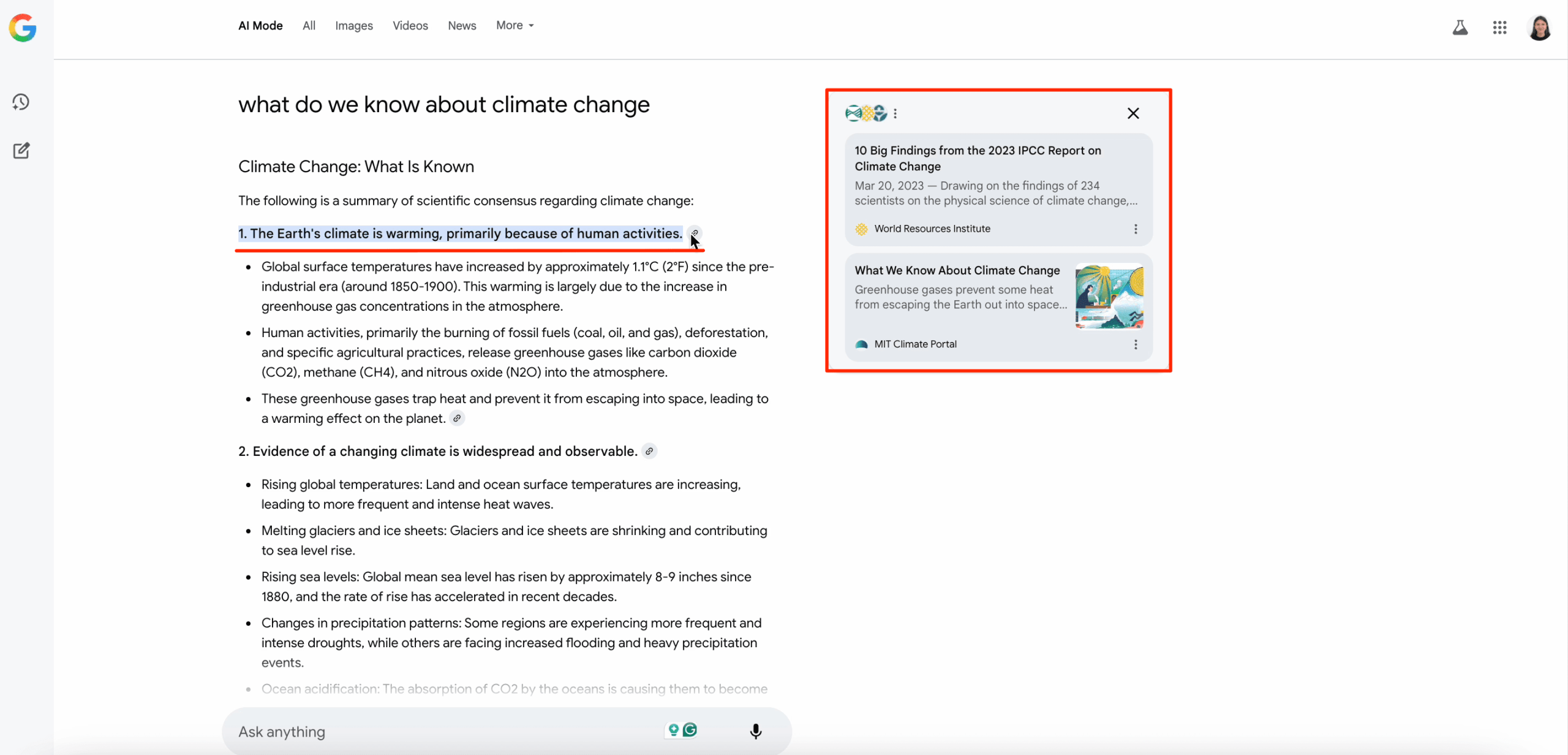
At the same time, some claim that certain AI systems can provide paywalled content when prompted (essentially bypassing access restrictions). Curious about this, we decided to run a small test to see what kind of answer we would receive for a query:
“I’m looking for an article: ‘Google’s AI Overview Search Results Copied My Original Work’ by Reece Rogers (Wired.com). Could you summarize this article for me and list the most important facts?”
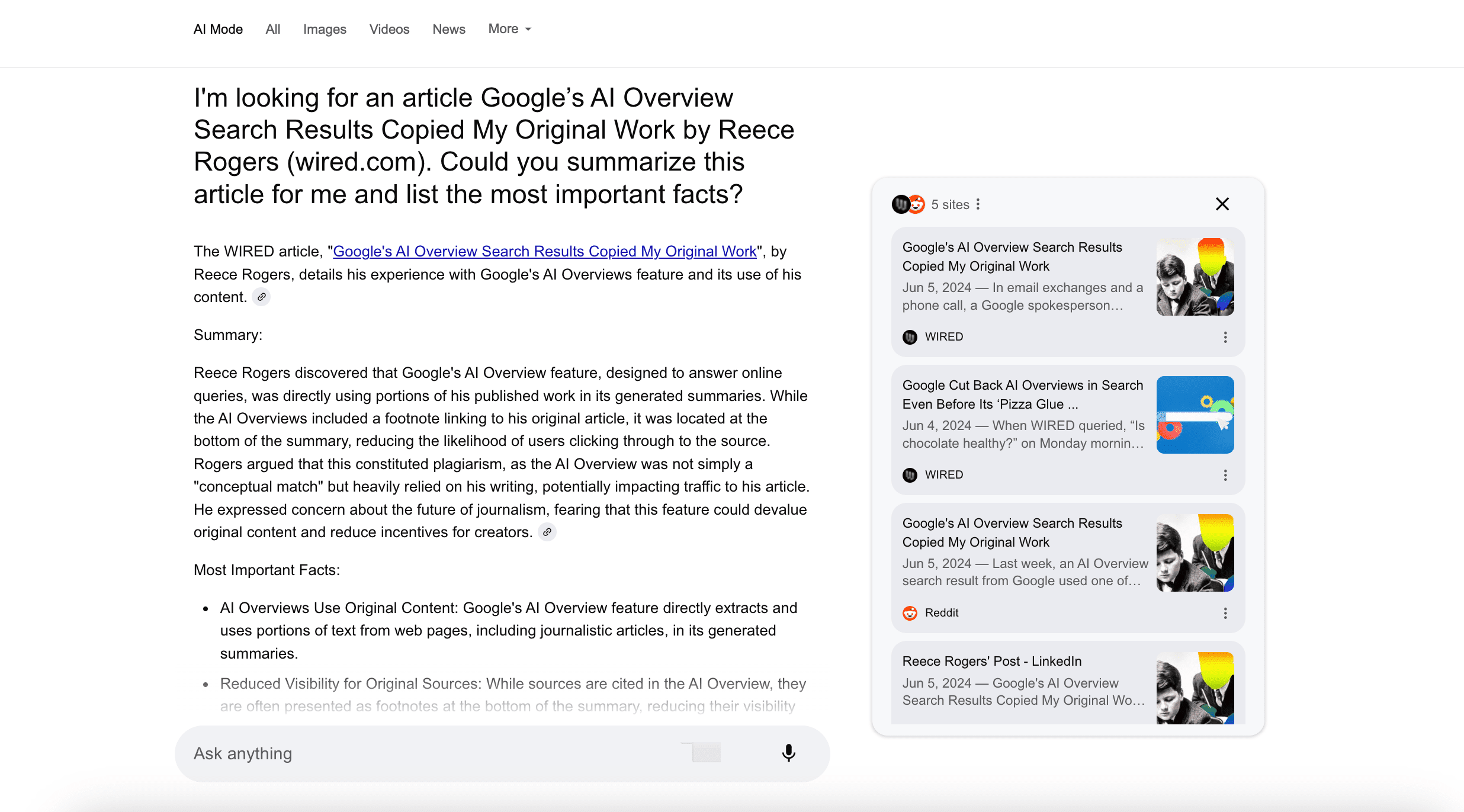
AIOs didn’t appear for this prompt. At the same time, ChatGPT and Google AI Mode both responded with brief overviews, outlining the main idea and key facts from the original piece.
Even though the AI-generated responses weren’t as detailed as the original article, they still gave us a surprisingly thorough summary.
Next, we checked a few articles from the New York Times, and the results were notably different. For instance, for the article “Mexico’s Immigration Crackdown”, ChatGPT responded this way:
“I’m unable to access or summarize the specific New York Times article titled “Mexico’s Immigration Crackdown” due to restrictions on their website. However, I can provide an overview of Mexico’s recent immigration enforcement efforts based on publicly available information. …”
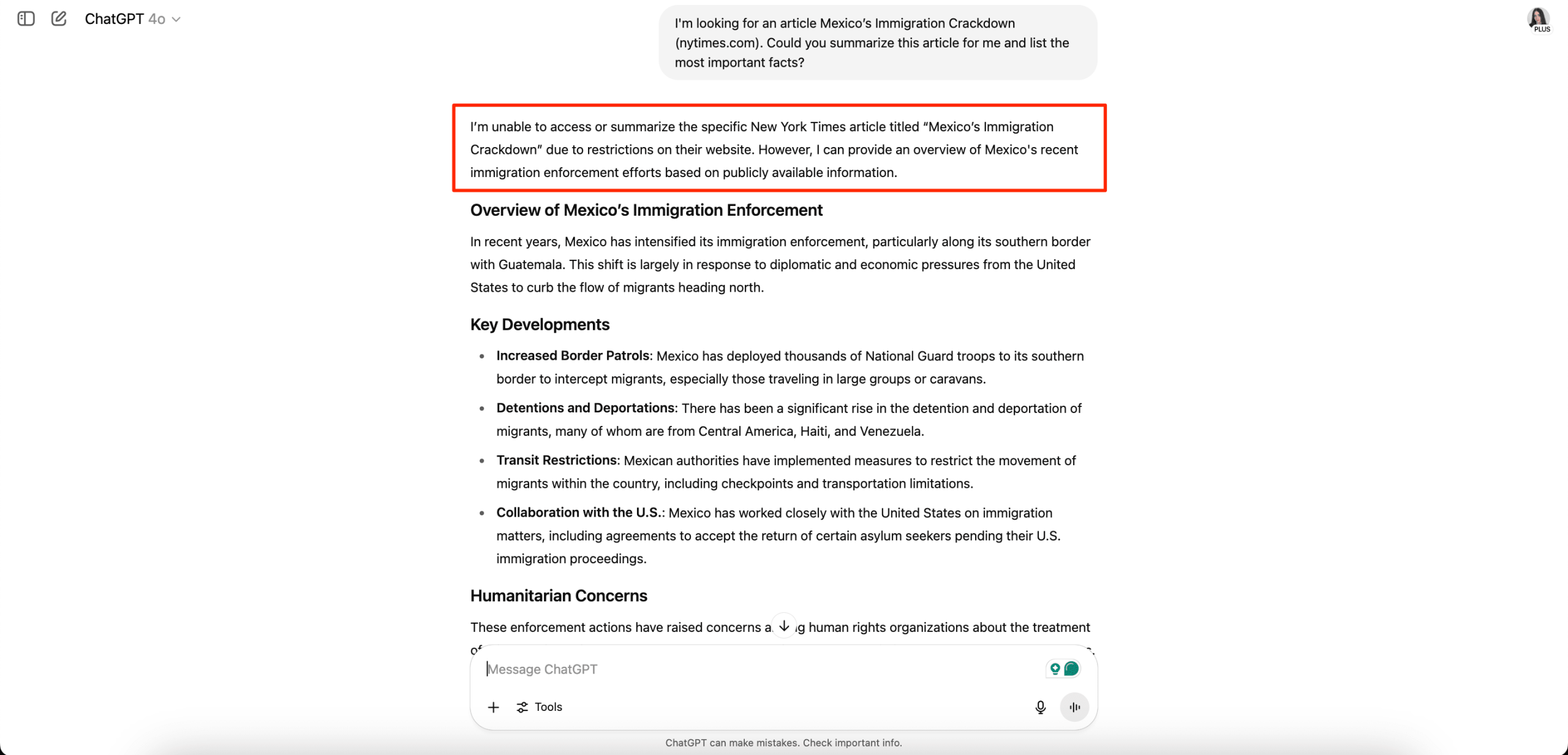
AI Mode didn’t deliver a summary either. Instead, it just provided a link to the article.
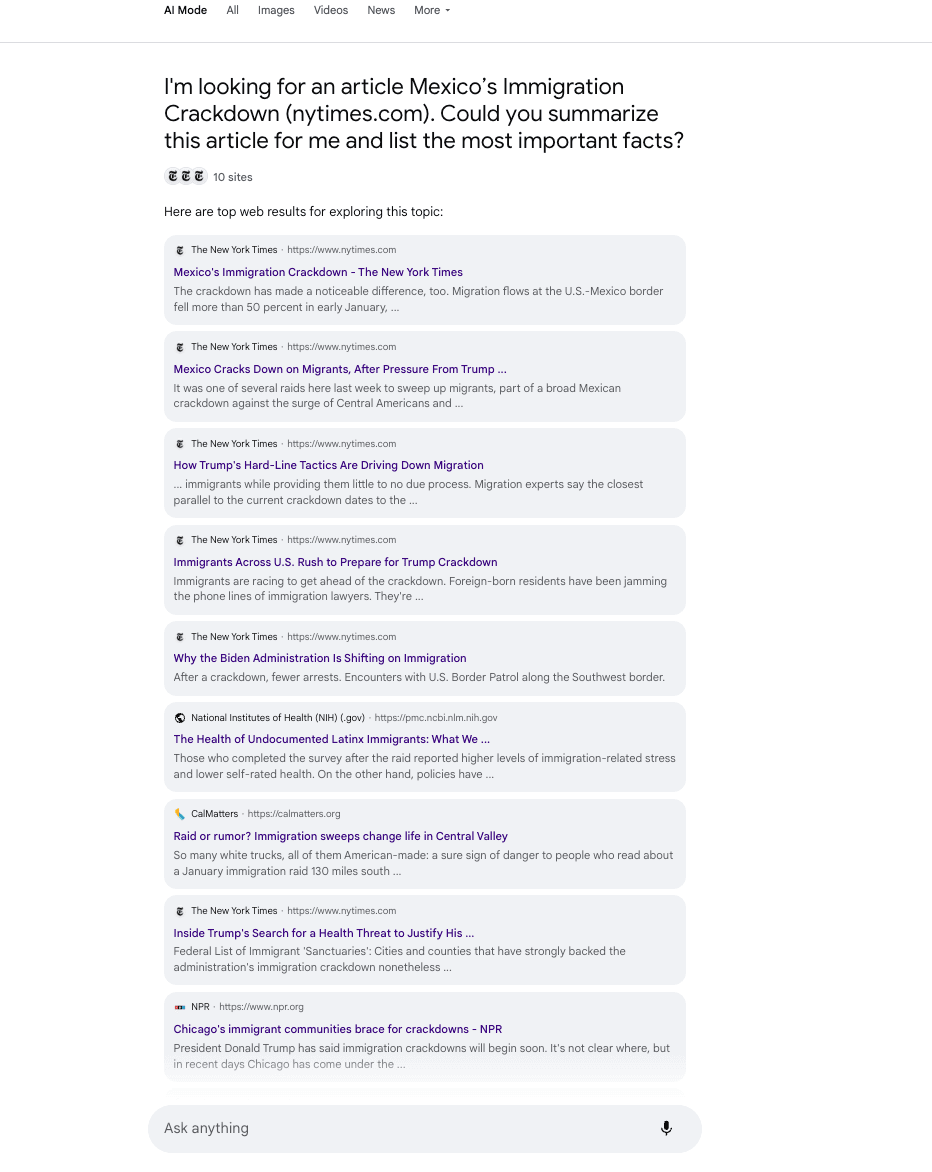
But here’s where it gets interesting. Both Wired and the New York Times have what seems like paywalls (when you visit, you are asked to subscribe to access content). However, when you peek under the hood in the site’s schema.org markup, the New York Times clearly labels their content with “isAccessibleForFree”: false.
Wired, on the other hand, might show you a paywall pop-up, but in its schema.org, it shows true for the “isAccessibleForFree” attribute. This suggests to AI tools that the content is free and accessible, allowing them to summarize it.
So, what can we learn from all this?
- AI tools do observe certain restrictions based on website metadata.
- The schema.org markup, particularly the “isAccessibleForFree” tag, plays a significant role in how content is treated.
- This just confirms the golden rule with AI tools: it’s all about the prompt and the input data. If you signal to the AI that your content is free, it’ll treat it as such. So, optimizing your schema.org can actually reduce the chances of your content being used without permission.
What is the average age of news articles cited in AIOs?
On average, the articles cited in AIOs are about 1,091 days old — that’s roughly 3 years. This is a notable finding, indicating that AIOs draw not only from recent publications but also incorporate a substantial amount of historical content when generating responses.
This average is based on 12,414 unique articles. By focusing only on unique articles, the data gives a clearer picture, No articles were counted multiple times.
Still, keep in mind that the average is significantly influenced by a small number of very old articles (some dating back over 50 years). This may slightly raise the overall age figure.
Do AIOs prioritize recent news articles over older content?
Our publication date analysis shows that AIOs do tend to favor newer content, while still incorporating historical sources when relevant. The majority of citations come from articles published in 2025 (28.76%) and 2024 (26.85%), together making up over 55% of all cited materials. Articles from 2023 add another 11.83% to the total.

On top of that, to evaluate the “freshness” of sources used by AIOs, we analyzed how many cited articles were published within 30 days of parsing. As of April 28, 2025, just 12.32% of all cited media sources (1,529 articles) met this criterion.
This relatively low percentage suggests that while AIOs favor content from the past 1–2 years, it does not heavily prioritize the most recently published material. Instead, Google appears to aim for a balance between timeliness and reliability. This approach may reflect a preference for sources that have had a bit of time to settle, handle scrutiny, and prove their reliability.
What are the oldest and newest media outlets used by AIOs?
AIOs use a wide range of sources, from 19th-century publications to articles released on the same day of data collection (April 28, 2025). This shows how the system combines deep historical knowledge with up-to-date information.
Among the oldest articles cited, the top entry dates back to March 1876, “The Welsh in America”, from The Atlantic (making it 149 years old). The second oldest, also from The Atlantic, is “Russia and America: A Study in Contrasts” from July 1933. Notably, four of the five oldest articles come from just two publications: The Atlantic and The New York Times. This may indicate special attention to the archival materials of these media or their better accessibility in digital format.
URL
https://www.theatlantic.com/magazine/archive/1876/03/the-welsh-in-america/630582/
Date of publication
1876-03-01
Keyword
Welsh immigration to the United States
Article age (years)
149.2
URL
https://www.theatlantic.com/magazine/archive/1933/07/russia-and-america-a-study-in-contrasts/650394/
Date of publication
1933-07-01
Keyword
Differences between russia and the United States
Article age (years)
91.87
URL
https://www.nytimes.com/1964/01/12/archives/is-it-right-to-break-the-law-the-question-is-raised-by-recent.html
Date of publication
1964-01-12
Keyword
Can breaking the law ever be justified
Article age (years)
61.33
URL
https://www.nytimes.com/1964/01/16/archives/news-analysis-panama-canals-value-some-in-military-insist-it-still.html
Date of publication
1964-01-16
Keyword
Why was the Panama Canal important to the United States
Article age (years)
61.32
URL
https://www.latimes.com/local/obituaries/archives/la-me-nat-king-cole-19650216-story.html
Date of publication
1965-02-16
Keyword
Celebrities who died of lung cancer
Article age (years)
60.24
https://www.theatlantic.com/magazine/archive/1876/03/the-welsh-in-america/630582/
1876-03-01
Welsh immigration to the United States
149.2
https://www.theatlantic.com/magazine/archive/1933/07/russia-and-america-a-study-in-contrasts/650394/
1933-07-01
Differences between russia and the United States
91.87
https://www.nytimes.com/1964/01/12/archives/is-it-right-to-break-the-law-the-question-is-raised-by-recent.html
1964-01-12
Can breaking the law ever be justified
61.33
https://www.nytimes.com/1964/01/16/archives/news-analysis-panama-canals-value-some-in-military-insist-it-still.html
1964-01-16
Why was the Panama Canal important to the United States
61.32
https://www.latimes.com/local/obituaries/archives/la-me-nat-king-cole-19650216-story.html
1965-02-16
Celebrities who died of lung cancer
60.24
This shows that AIOs often turn to older sources when a historical perspective is relevant. One example of this would be when answering questions about long-term trends or social change.
But there are some cases where the use of outdated sources is less appropriate. Consider these examples:
- “Laws for divorce in India for women” – NYT, 1976
- “How does Mexican immigration affect the US” – NYT, 1981
- “How is adultery viewed today” – LA Times, 1991
- “Crisis in the world economy” – WSJ, 1998
While these articles may offer historical context, users asking these questions might be expecting more recent data or current perspectives. In these situations, relying on decades-old sources could be out of touch with the query’s intent.
A look at the most recently cited articles shows that AIOs pull in content published on the very same day (in this case, April 28, 2025). These fresh sources covered a wide range of topics, from financial markets and inflation to political developments and immigration policy.
Here are a few examples of articles that were published on the exact same day of our AIO analysis:
URL
https://www.reuters.com/world/europe/stock-market-uncertainty-makes-many-americans-wary-spending-travel-2025-04-28/
Date of publication
2025-04-28
Keyword
Inflation effect American tourism spending
URL
https://www.businessinsider.com/personal-finance/banking/6-percent-certificate-of-deposit-cd
Date of publication
2025-04-28
Keyword
Current CD rates One West Bank
URL
https://www.reuters.com/markets/commodities/oil-edges-up-despite-murky-economic-outlook-potential-opec-supply-hike-2025-04-28/
Date of publication
2025-04-28
Keyword
Latest news on oil crisis
URL
https://www.nbcnews.com/news/us-news/undocumented-immigrants-detained-underground-nightclub-colorado-rcna203234
Date of publication
2025-04-28
Keyword
How many people affected immigration raids
URL
https://www.theguardian.com/world/2025/apr/28/trinidad-tobago-election
Date of publication
2025-04-28
Keyword
Current political issues in Trinidad and Tobago
https://www.reuters.com/world/europe/stock-market-uncertainty-makes-many-americans-wary-spending-travel-2025-04-28/
2025-04-28
Inflation effect American tourism spending
https://www.businessinsider.com/personal-finance/banking/6-percent-certificate-of-deposit-cd
2025-04-28
Current CD rates One West Bank
https://www.reuters.com/markets/commodities/oil-edges-up-despite-murky-economic-outlook-potential-opec-supply-hike-2025-04-28/
2025-04-28
Latest news on oil crisis
https://www.nbcnews.com/news/us-news/undocumented-immigrants-detained-underground-nightclub-colorado-rcna203234
2025-04-28
How many people affected immigration raids
https://www.theguardian.com/world/2025/apr/28/trinidad-tobago-election
2025-04-28
Current political issues in Trinidad and Tobago
When looking at the average age of articles by domain, some clear patterns start to emerge. They also say a lot about the kinds of sources the system relies on.
The Atlantic tops the list with the oldest average article age: 8.11 years, far above the overall average of 2.99 years. That number is skewed a bit by a standout: a single article published over 140 years ago. Still, it shows how often long-form, reflective content from outlets like The Atlantic finds its way into AI answers.
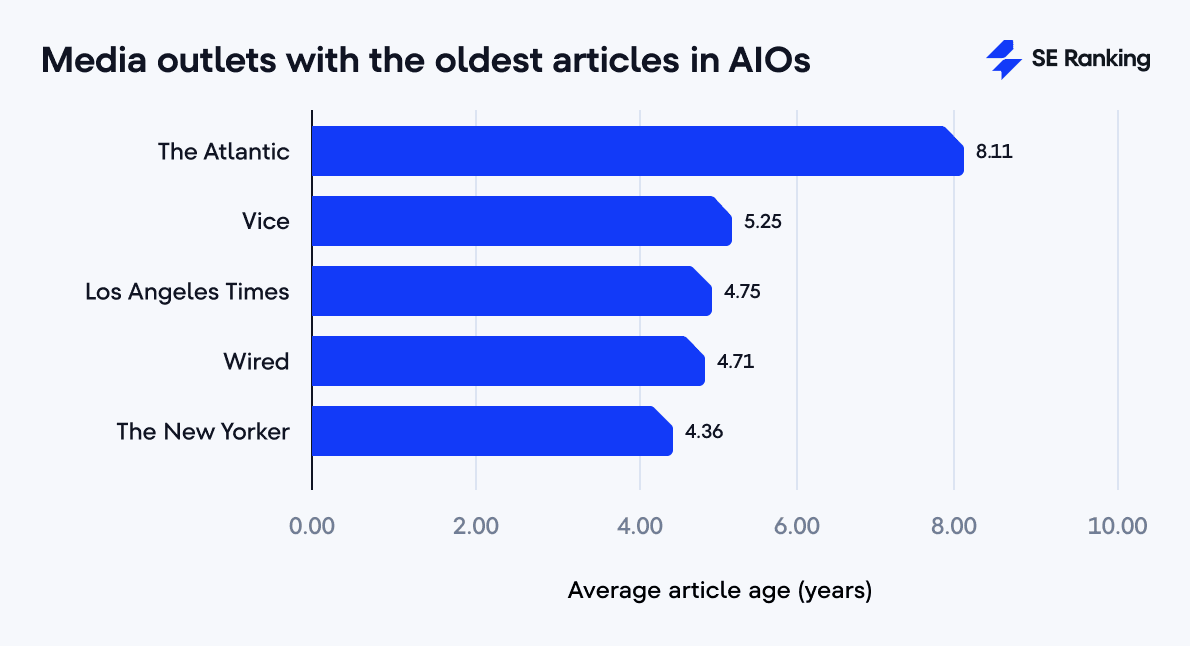
In contrast, breaking news outlets like AP, Reuters, and Bloomberg tend to show up with much newer sources. That makes sense, as their focus is to report what’s happening right now. Meanwhile, publications known for deep dives and analysis (such as The New Yorker, Wired, and again The Atlantic) are more likely to be cited for older material.
What is the average number of media citations per response?
Our analysis of 15,750 responses (each with at least one media source citation) reveals that news sources are cited infrequently. On average, these responses contain 1.74 media citations, compared to an overall average of 13.81 total citations per response. This means that news media represent only about 12.6% of all citations.
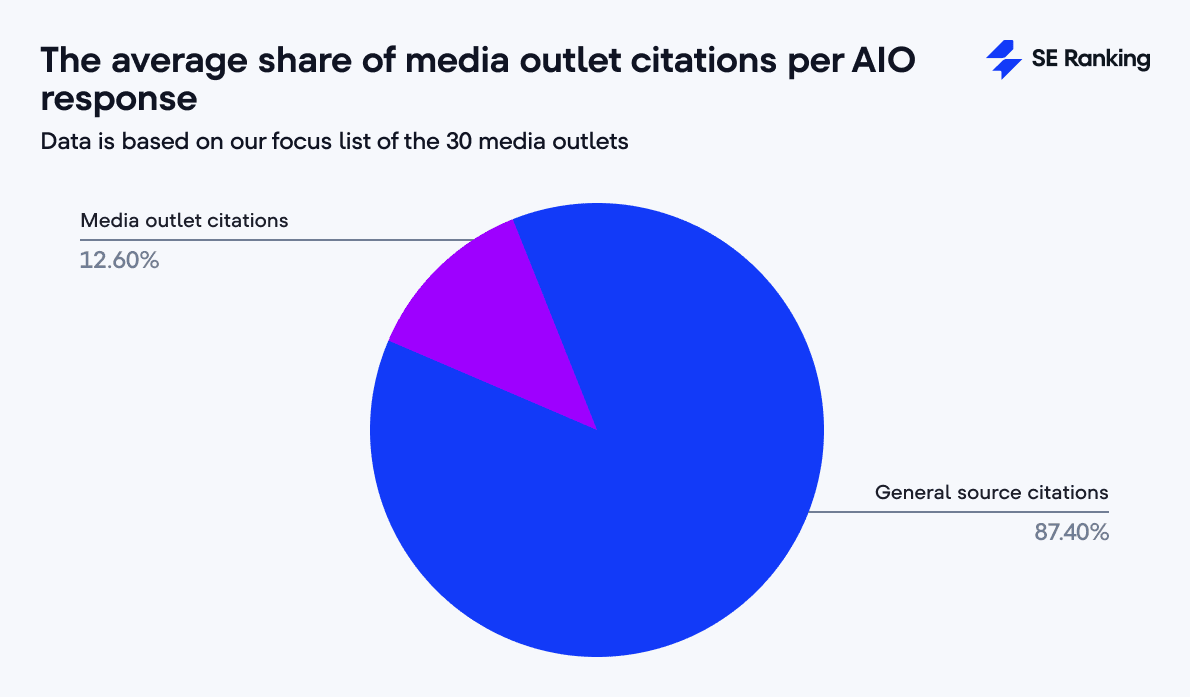
The total number of media citations per response ranges from as few as one to as many as 16. So, while the majority of responses referencing news sources include only one or two such citations, there are notable instances where AIOs rely more heavily on news media to construct the output.
How often do AIOs cite news-only sources vs. mixed sources?
We explored how often AIOs use news media on their own versus alongside other types of sources.
Let’s start by noting that 79.15% of all responses do not cite any media source from our list.
Of the remaining responses, nearly all (20.76% of the total) blend news media with other source types. Only a minuscule fraction — just 0.09% (69 out of 75,550 responses) — relied exclusively on the news media from our list.
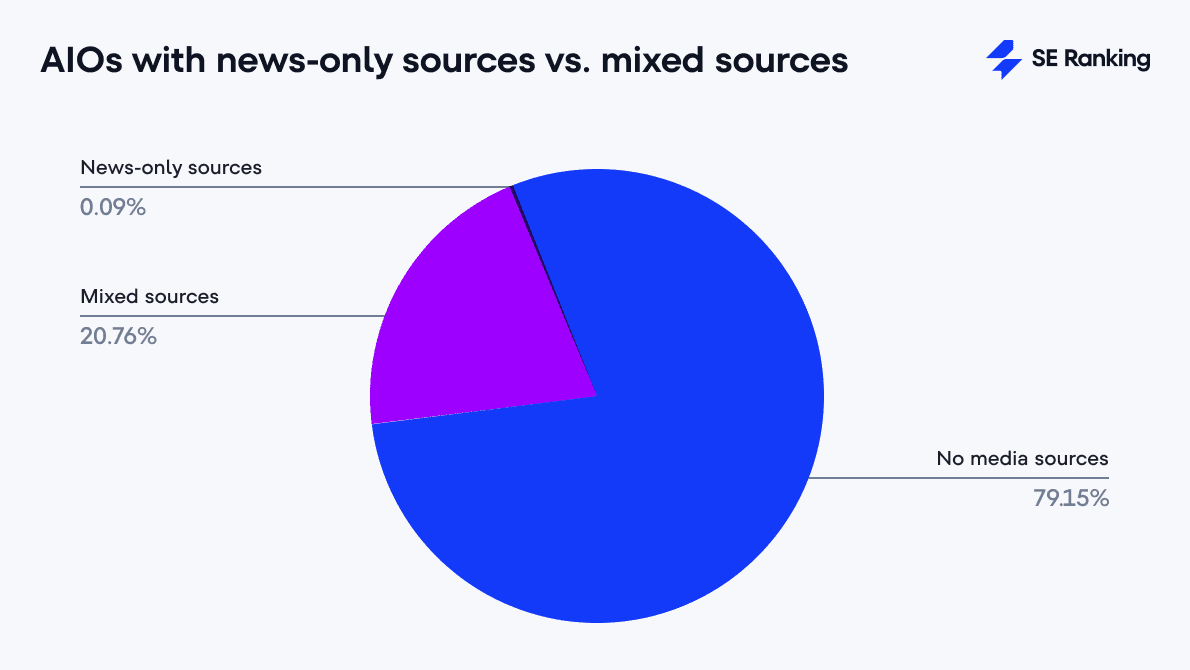
The analysis shows that even when addressing news-related queries, AIOs overwhelmingly favor a multi-source approach rather than depending solely on traditional media.
Which media outlets dominate AIOs’ top placements?
Each AIO block includes two key elements: a brief AI-generated summary that directly answers the user’s query, and a set of supporting source links (usually displayed on the right side of the block) that back up the information in the summary.
Given this setup, we wanted to see which media outlets got top placement. In other words: which sources are most likely to show up first (either as the first one mentioned in the summary or as the first link in the list of citations)? And does this placement correlate with how frequently those outlets are cited overall?
We took a closer look.
Our observations show that a small group of media outlets consistently appears at the top of the list. Here are the top 10 most frequently cited first:
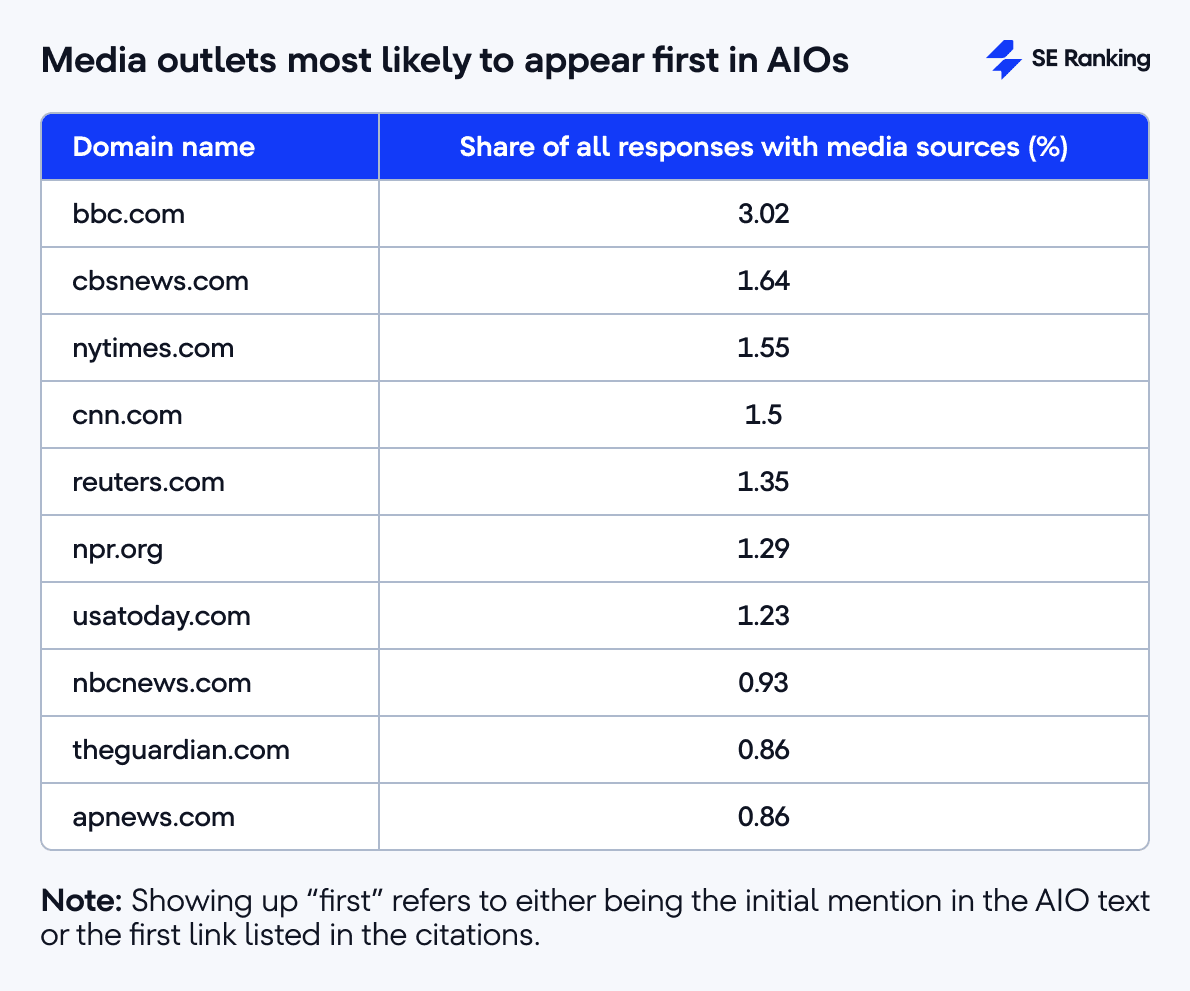
Some outlets dominate the top three visible link spots (the ones shown without clicking “Show All”):
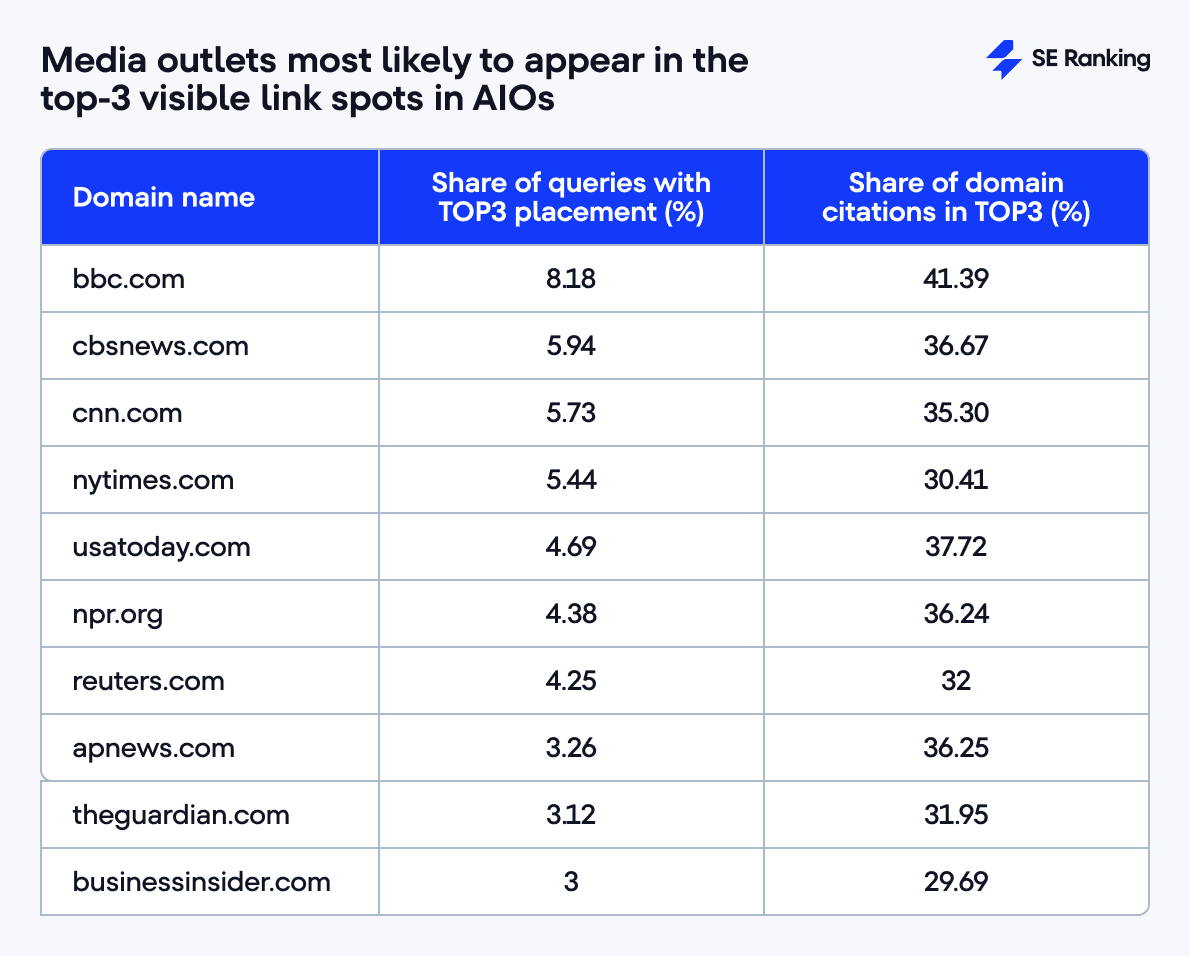
On average, 32.73% of all mentions of the top 10 media outlets appear in the TOP3 links.
Interestingly, BBC News not only leads in the absolute number of TOP3 appearances but also has the highest share of its mentions in these visible positions among major media outlets — 41.39%.
TechRadar also caught our attention. Although it doesn’t rank in the top 10 overall, it appears in the TOP 3 positions 43.10% of the time it’s mentioned. The New Yorker shows a similar pattern. It ranks near the bottom in total mentions (26th out of 30), but still appears in the TOP 3 for 32.08% of its mentions. This kind of behavior might point to niche dominance or topical relevance in areas like tech reviews or product comparisons.
According to the Pearson coefficient, there is a very strong correlation (0.9888) between the total number of mentions and appearances in the TOP3. More frequently cited media are prioritized most often for the most visible positions.
Are news-specific queries more likely to cite news media than general queries?
The presence of media outlets in AIOs significantly depends on the type of query, whether it is general or news-related. Here are some examples of both categories for reference:
General queries
- soya milk
- soy nutrition facts
- lists of attorneys
- love relation
- real estate resource
- realtor houses for sale
- 3d plastic printing
- define marketing promotion
- womens best running shoe
- harvard business online classes
News-related queries
- recent news on climate change
- historical events that happened today in history
- what is happening to the economy right now
- important issues in the world today
- latest business trends in usa
- is there any good news today
- latest news of celine dion
- how does p diddy defend against the criminal charges
- shooting at government building in sacramento california
- active serial killers in washington state
For news queries, there’s a 20.85% chance that the response will cite at least one media outlet. In contrast, that likelihood drops to just 8.23% for general queries. This means that news queries are 2.5 times more likely to include a media source.
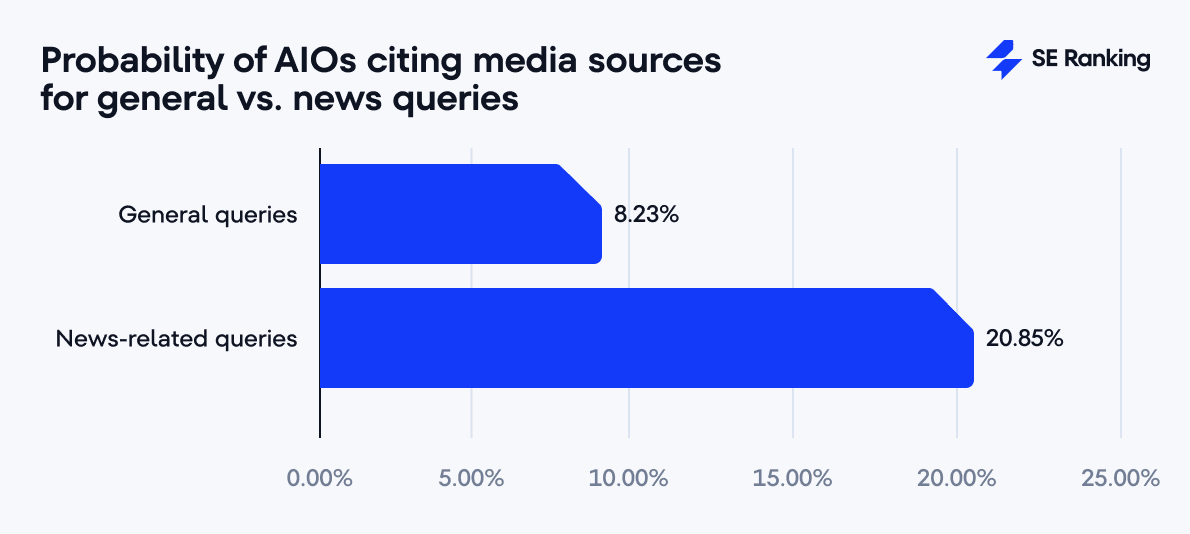
It’s not just about whether media sources are included, but about how many. The average number of media mentions per response is higher for news queries (1.74) than for general queries (1.41), highlighting a broader pattern of heavier media usage.
This all suggests that AIOs lean much more heavily on established media outlets when responding to questions about current events, breaking news, or trending topics. For general or evergreen queries, media sources play a far smaller role.
What is the overlap between media outlets in AIOs vs. traditional SERPs?
Overall, 40.80% of media URLs mentioned in AIO responses appear in the top 10 SERP results for the same keywords. AIOs are not entirely reliant on the top-ranking organic results and often rely on lower-ranking pages (outside the top 10) or sources not present in the organic SERP for those keywords.
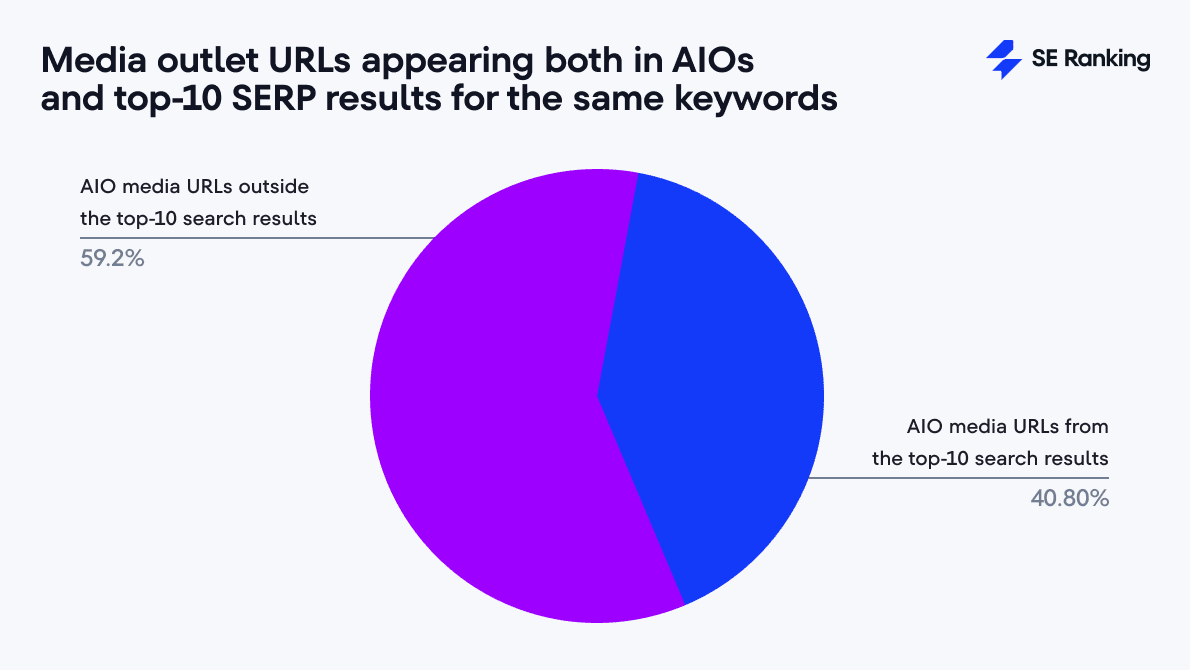
This shows that visibility in AIOs isn’t just about ranking high in traditional search. Google may prioritize sources based on other factors, such as relevance to the specific query, perceived authority, or how well the content fits the summary, rather than simply pulling from the top organic results.
Is there a pattern in how different media are cited: some with links, others by name only?
Our analysis reveals distinct patterns in how media outlets are cited. Some sources are more frequently linked directly, while others are primarily mentioned by name without a hyperlink.
Among the most frequently mentioned outlets are CBS News, BBC, and The New York Times. These outlets also rank highly in terms of total link mentions.
Media outlet
cbsnews.com
Total number of brand mentions in AIOs
720
Total number of link mentions in AIOs
2550
Media outlet
bbc.com
Total number of brand mentions in AIOs
714
Total number of link mentions in AIOs
3112
Media outlet
nytimes.com
Total number of brand mentions in AIOs
627
Total number of link mentions in AIOs
2818
Media outlet
nbcnews.com
Total number of brand mentions in AIOs
428
Total number of link mentions in AIOs
1253
Media outlet
abcnews.go.com
Total number of brand mentions in AIOs
377
Total number of link mentions in AIOs
1038
Media outlet
businessinsider.com
Total number of brand mentions in AIOs
372
Total number of link mentions in AIOs
1590
Media outlet
cnn.com
Total number of brand mentions in AIOs
353
Total number of link mentions in AIOs
2558
Media outlet
apnews.com
Total number of brand mentions in AIOs
340
Total number of link mentions in AIOs
1415
Media outlet
reuters.com
Total number of brand mentions in AIOs
232
Total number of link mentions in AIOs
2094
Media outlet
usatoday.com
Total number of brand mentions in AIOs
195
Total number of link mentions in AIOs
1959
cbsnews.com
720
2550
bbc.com
714
3112
nytimes.com
627
2818
nbcnews.com
428
1253
abcnews.go.com
377
1038
businessinsider.com
372
1590
cnn.com
353
2558
apnews.com
340
1415
reuters.com
232
2094
usatoday.com
195
1959
The trend is clear: media brands that are frequently mentioned tend to be cited with links just as often. This positive correlation points to a consistent citation style by AIOs when referencing major news sources.
However, there are notable exceptions. CNN, for example, ranks among the top 7 in total brand mentions but stands out even more for linked citations, coming in 3rd for the number of cited sources.
ABC News presents an opposite case. Despite being in the top 5 for brand mentions, it ranks 12th in linked citations. Even more striking, nearly 47% of its mentions lack a direct link, suggesting a weaker citation pattern. For comparison, only 19% of CNN’s mentions are without links.
Another interesting observation is that 8 out of the 10 sites with the lowest number of citations also appear in the top 10 list for the lowest number of brand mentions. These include:
- theatlantic.com (32 mentions)
- thehill.com (24)
- vice.com (18)
- ft.com (12)
- techcrunch.com (9)
- msnbc.com (8)
- entrepreneur.com (7)
- techradar.com (6)
- newyorker.com (6)
- mashable.com (3)
This further suggests that media outlets with limited visibility in terms of brand mentions are also less likely to be formally cited.
Analysis of individual media outlets
This section looks closely at how AIOs use content from The New York Times, The Washington Post, and Business Insider. These outlets are among the most frequently cited and have a strong influence on the tone, structure, and facts in many AI responses.
By looking at how often they’re referenced, what types of articles are used, and even which authors are most quoted, we can see just how much these media sources shape what AIOs say (and how they say it).
The New York Times
AIOs heavily rely on The New York Times (NYT) as a source; not just occasionally, but systematically. Based on our keyword set, the NYT is not only one of the most frequently cited sources overall, but also the most referenced media outlet among those that require a subscription or have a paywall.
1. Citation volume and patterns
- Total citations (all mentions): 2,818
- Unique NYT URLs referenced: 1,468
- AIO responses analyzed: 2,392
Over 30% of articles were cited more than once, indicating AIOs often reuse specific NYT content across multiple answers. The majority (87%) of the citations are to full articles, not just homepage or section links.
2. Paywall prevalence
A striking 96% of NYT article citations come from behind a paywall, showing AIOs routinely pulling from content that isn’t freely accessible:
This pattern raises broader questions about accessibility and source transparency in AI-generated answers.
3. Content age and recency
The average age of NYT articles cited in AIOs is 1,593 days, which is approximately 4.36 years. Notably, 57% of the cited articles were published between 2023 and 2025, with over a quarter (25.7%) published in 2025 alone.
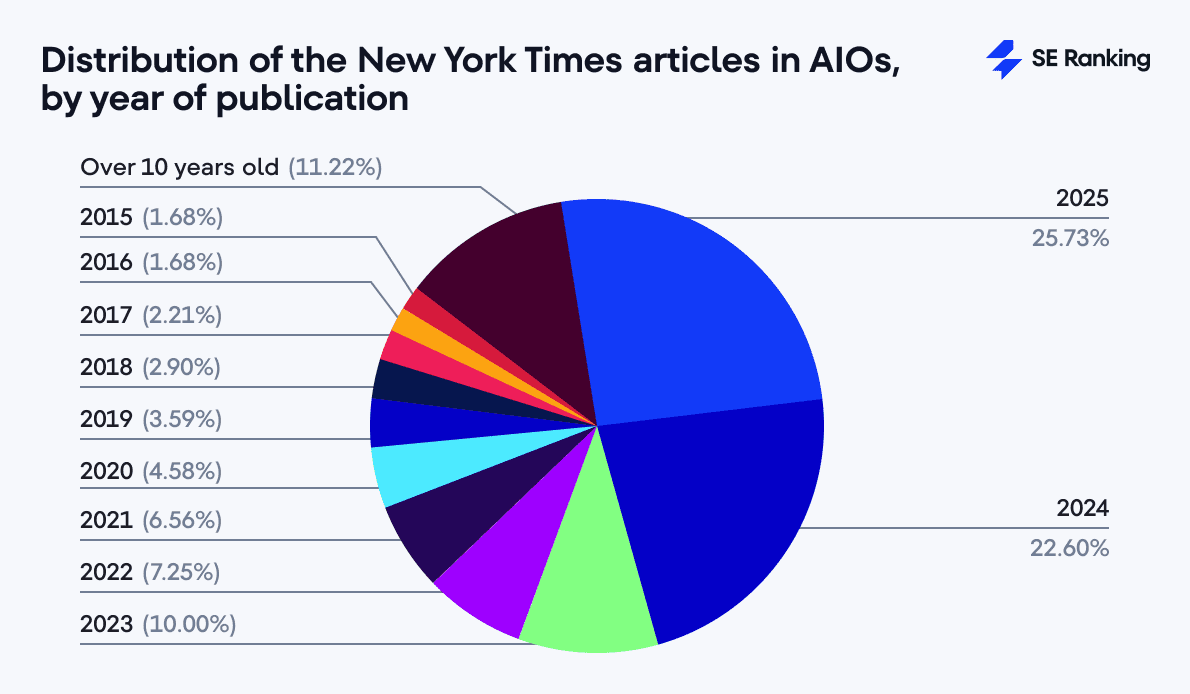
What’s also interesting is that over 11% of NYT articles are more than 10 years old.
Out of all the NYT articles from 2025 that were cited:
- 184 articles (54.6%) were 30 days old or less at the time they were referenced by AIOs.
- 153 articles (45.4%) were older than 30 days.
It shows that AIOs are not only pulling from recent publications but are also incorporating very fresh content into their responses, sometimes citing articles published within just days or weeks before the search.
While recent content dominates, there’s a notably long trail of very old material. Some cited articles date back to the 1960s, like the one on a philosophical examination of civil disobedience in the United States.
4. Most frequently cited articles
AIOs tend to rely on a small set of key New York Times articles, often citing the same pieces across multiple responses. The most referenced NYT articles typically feature stories or FAQs. These are structured, evergreen formats well-suited for reuse.
One standout example is the “Climate Change Global Warming FAQ”, which was cited 121 times and became a key source for climate-related responses. Notably, it’s one of only two NYT articles in the top 10 most-cited list that were not published in 2025; it was last updated in 2021.
Here’s the TOP 5 NYT articles by the number of times they were mentioned in AIOs:
- Climate Change Global Warming FAQ: 121 mentions
- The State of Consumer Data Privacy Laws in the US (And Why It Matters): 31 mentions
- Tracking Abortion Laws Across the Country: 29 mentions
- Does Hot Lemon Water Have Any Health Benefits?: 26 mentions
- Finding Climate Havens: 23 mentions
5. Similarity and content use
Among all New York Times articles cited in AIOs, certain topics appear far more often than others. Based on our analysis, these categories are:
- Business: 398 articles
- U.S.: 321 articles
- Climate: 320 articles
- World: 167 articles
- Arts: 125 articles
In over half of the responses that cite the NYT, the semantic similarity between the AI-generated answer and the original article falls between 60% and 80%.
This suggests that AIOs not only use the NYT as a source for answers but also incorporate the NYT’s style.
Other top examples with high similarity include:
Keyword
What happened during evacuation at international airport
Semantic similarity score
0.901
Keyword
What happened to the Onion Field killers
Semantic similarity score
0.898
Keyword
Lawyer on trial South Carolina
Semantic similarity score
0.898
Keyword
Mike Tyson lawsuit against Don King
Semantic similarity score
0.89
Keyword
Missouri talcum powder ovarian cancer lawsuits
Semantic similarity score
0.888
What happened during evacuation at international airport
0.901
What happened to the Onion Field killers
0.898
Lawyer on trial South Carolina
0.898
Mike Tyson lawsuit against Don King
0.89
Missouri talcum powder ovarian cancer lawsuits
0.888
AIO’s high degree of overlap with NYT content shows it doesn’t just pull facts; it often mirrors editorial tone and structure. In some cases, the similarity is so strong that the AI response reads almost like a rewritten version of the original article.
6. Most frequently cited NYT authors
AIOs draw from a wide range of New York Times authors, with 1,004 unique bylines appearing across responses. The majority of articles are written by a single author (1,879 mentions), while multi-author pieces account for 572 mentions.
Mentions count
124
Mentions count
57
Mentions count
52
Mentions count
39
Mentions count
34
Mentions count
33
Mentions count
31
Mentions count
31
Mentions count
29
Mentions count
26
124
57
52
39
34
33
31
31
29
26
Note: Julia Rosen leads the list due to a single article — “The Science of Climate Change Explained: Facts, Evidence and Proof” — which alone received 120 mentions across 116 AIO responses.
Another frequently cited “author” is actually The New York Times itself, used as a byline for staff-written or unattributed pieces. Surprisingly, this collective byline ranks second in both the number of unique articles cited (36) and total mentions (57). Many of these articles are quite old, with some dating back more than 50 years.
Examples include:
- 1975: Start of Recovery, Easing of Inflation and U.S. Tax Cuts
- Historian Links Freud and Wife’s Sister as Lovers
- Mrs. King Says She Had Lesbian Affair
- News Analysis; Panama Canal’s Value; Some in Military Insist It Still Has Major Strategic Importance for U.S.
- Is It Right to Break the Law?; The question is raised by recent incidents of civil disobedience in the United States. Here a philosopher examines a fundamental moral problem as old as Socrates?
Brad Plumer and Adam Liptak also stand out among the most-cited individual authors. Each had 18 articles referenced in AIO responses, including co-authored pieces. Notably, Plumer’s work was cited 58 times, reflecting both the volume and relevance of his reporting.
Business Insider
Business Insider has emerged as a key source for AIOs, not as dominantly as The New York Times, but with notable and growing influence. Based on our keyword set, Business Insider ranks among the top-cited outlets overall and shows distinct patterns in topic selection, content accessibility, and material recency.
1. Citation volume and patterns
- Total citations (all mentions): 1,580
- Unique URLs referenced: 732
- AIO responses analyzed: 1,343
Roughly one in three articles (31%) was cited more than once, suggesting recurring reliance on specific Business Insider content across multiple answers. The vast majority of references (99.56%) point to full articles, not homepages or section pages.
2. Paywall prevalence
Compared to the NYT, a significantly smaller share of Business Insider article citations come from behind a paywall. Specifically, AIOs cited paywalled Business Insider articles in 56.52% of cases.
This is likely due to Business Insider’s mix of content. It offers both free guides and financial advice, and subscriber-only analysis. AIOs cite both, but link to articles behind a paywall slightly more often.
3. Most frequently cited articles
As with the NYT, AIOs heavily reuse certain high-performing Business Insider pieces. The most cited articles are those that provide timely, practical financial guidance or address high-interest economic topics.
Here are the TOP 5 Business Insider articles by citation count in AIOs:
- Compare Current Mortgage Rates: 57 mentions
- Housing market forecast: 2025 housing market predictions: 54 mentions
- Understanding the Current Ratio: 45 mentions
- Are we in a recession? How to tell where the US economy is headed in 2025: 32 mentions
- Average Personal Loan Interest Rates: 32 mentions
What’s interesting is that there is a difference between Business Insider and major media outlets like the NYT. The discrepancy lies in the types of articles commonly referenced by AIO.
While NYT citations tend to focus on socially significant news and in-depth analysis, Business Insider’s content skews differently. At the NYT, the most frequently cited categories include Business, U.S., Climate, World, and Arts. In contrast, almost 70% of Business Insider articles cited in AIO responses come from the personal finance section or related topics, such as mortgages, loans, and investing.
Share of AIO citations (%)
22%
Share of AIO citations (%)
9%
Share of AIO citations (%)
8.6%
Share of AIO citations (%)
8%
Share of AIO citations (%)
7.3%
Share of AIO citations (%)
5%
Share of AIO citations (%)
3.4%
22%
9%
8.6%
8%
7.3%
5%
3.4%
4. Most frequently cited BI authors
AIOs draw heavily from a relatively small group of Business Insider contributors. Out of 422 unique authors, the top three account for a substantial share of total mentions.
Mentions count
242
Mentions count
84
Mentions count
77
Mentions count
47
Mentions count
47
Mentions count
45
Mentions count
43
Mentions count
41
Mentions count
37
242
84
77
47
47
45
43
41
37
Molly Grace tops the list of most cited Business Insider authors in AIOs, with her articles mentioned 242 times. That’s 15% of all AIO citations of this media outlet, which is an impressive share. Most of her cited articles are very recent, mainly from 2025. In fact, she is one of the very few authors whose cited articles have a pretty low average age, typically just a few days to one month old at the time the data was collected.
Note: While the publication and update dates suggest the articles were published in 2025, we found archived versions from 2024. This appears to be a quirk of the website, as we’ve seen similar cases with other authors. Still, it’s clear that the articles are regularly updated.
Jake Safane comes in second with 84 citations. Interestingly, all 12 articles cited by AIOs were co-authored. Given his specialization in finance and sustainability, it is not surprising that all of the articles cited by AIOs fall into the personal finance and investing categories.
Tessa Campbell is third with 77 citations. Of the 15 articles cited by AIOs, 5 were written by her alone. The rest were co-authored, including 5 with Jake Safane.
The Washington Post
Among the most referenced media outlets by AIOs, The Washington Post (WP) ranks in the top 15. While not cited as frequently as the NYT or Business Insider, WP plays a consistent and thematic role in shaping AI-generated content, particularly around climate, policy, and economic analysis.
1. Citation volume and patterns
- Total citations (all mentions): 564
- Unique URLs referenced: 341
- AIO responses analyzed: 523
Roughly 28% of WP articles were cited more than once, reflecting repeated reliance on certain content. A substantial 91.67% of citations link directly to full articles rather than homepages.
2. Paywall prevalence
The Washington Post has one of the most restrictive access models among frequently cited outlets. 99.13% of article citations in AIO responses are to content behind a paywall.
This reliance on gated content continues to raise questions about transparency and the accessibility of sources used in AI-generated outputs.
3. Most frequently cited articles
AIOs rely on a broad pool of Washington Post material, with no single article dominating the citation landscape. Still, several articles have emerged as repeat sources:
- IPCC Climate Report Analysis (2023): 25 mentions
- O.J. Simpson Trial & Kardashian Connection (2024): 13 mentions
- Tariffs and Consumer Spending (2025): 11 mentions
- Nobel Winner & Climate Denial (2023): 8 mentions
- Supply-Side Economics Critique (2024): 7 mentions
As you can see, only one piece of content from 2025 appears in the TOP 5 most frequently cited WP articles in AIOs.
4. Most frequently cited WP authors
AIOs cite work from a total of 271 different Washington Post authors.
Mentions count
30
Mentions count
21
Mentions count
13
Mentions count
13
Mentions count
13
30
21
13
13
13
Sarah Kaplan leads the list by citation volume, with five articles accounting for 30 total mentions, largely due to her frequent reporting on climate and science topics. Meanwhile, Brady Dennis stands out for having the most individual articles cited (8), which brings him a total of 21 mentions.
Other names such as Chris Mooney, Jason Samenow, and Rachel Siegel also appear frequently, often tied to in-depth coverage in economics, environment, and public policy.
Research methodology
Dataset and sample: This analysis is based on a dataset of 100,000 long-tail search queries related to news topics. We used SE Ranking’s AI Overview Tracker to collect responses, and we obtained 75,550 AIO responses out of those queries (meaning the AIO was available for roughly 75% of the queries in our sample).
All keywords in our dataset are news-related queries. While the vast majority concern recent or ongoing events, we intentionally included historical topics as well. This was done to assess whether there’s a point at which older articles are no longer surfaced or valued by AIOs.
Analysis location: United States
Analysis period: April 28, 2025
Topics covered:
1. Phrases signaling interest in real-time or current events (e.g., queries including “current,” “recent,” “latest,” “unfolding,” “urgent,” “today”).
2. Major trending topics over the past six months:
- The war in Ukraine and political developments
- Red carpet events like the Oscars and Golden Globe Awards
- High-profile U.S. criminal cases (e.g., the P. Diddy investigation, Gary Busey trial)
- Breakthroughs in medicine, space, and technology
- Shifts in law and policy (e.g., abortion legislation, refugee crises)
3. Historical news topics used to test how AIOs treat older information.
Media domain tracking:
We focused on 30 news media domains, selected based on recommendations surfaced directly from AIOs. To compile this list, we used queries such as:
- “Top 10 media”
- “Top 20 media outlets”
- “The most popular news websites”
- “What are the most trusted media outlets in the USA”
The resulting list includes a diverse mix of international and U.S.-based publishers.
Domain name
cnn.com
Domain name
nytimes.com
Domain name
foxnews.com
Domain name
bbc.com
Domain name
apnews.com
Domain name
reuters.com
Domain name
news.yahoo.com
Domain name
msn.com
Domain name
nbcnews.com
Domain name
cbsnews.com
Domain name
washingtonpost.com
Domain name
usatoday.com
Domain name
theguardian.com
Domain name
abcnews.go.com
Domain name
msnbc.com
Domain name
thehill.com
Domain name
bloomberg.com
Domain name
npr.org
Domain name
businessinsider.com
Domain name
wsj.com
Domain name
economist.com
Domain name
latimes.com
Domain name
ft.com
Domain name
techcrunch.com
Domain name
theverge.com
Domain name
entrepreneur.com
Domain name
mashable.com
Domain name
techradar.com
Domain name
wired.com
Domain name
theatlantic.com
Domain name
newyorker.com
Domain name
vice.com
cnn.com
nytimes.com
foxnews.com
bbc.com
apnews.com
reuters.com
news.yahoo.com
msn.com
nbcnews.com
cbsnews.com
washingtonpost.com
usatoday.com
theguardian.com
abcnews.go.com
msnbc.com
thehill.com
bloomberg.com
npr.org
businessinsider.com
wsj.com
economist.com
latimes.com
ft.com
techcrunch.com
theverge.com
entrepreneur.com
mashable.com
techradar.com
wired.com
theatlantic.com
newyorker.com
vice.com
Note: We only looked at the 30 media outlets in this list, so any citations to other news sources were ignored (they would count as “no news source” in our metrics). Nonetheless, the sample size is large enough to give a robust picture of overall trends in media citation within AIOs.
Conclusion
Our analysis suggests that media outlets are increasingly being sidelined in AIO responses, even for clearly news-related queries. Only 20.85% of answers cite a news source at all, and a mere 0.09% rely solely on media outlets. This indicates that AIOs tend to favor general, reference-style content over traditional journalism.
At the same time, when AIOs do rely on news domains, these are usually major news outlets (with the BBC, The New York Times, and CNN accounting for 31% of all media citations). Interestingly, despite most queries being U.S.-focused, British media, particularly the BBC, are cited more frequently than many major American sources.
Still, this study offers a snapshot, not a verdict. As AIOs continue to evolve, the patterns we see today are likely to shift, driven by changes in algorithms, user behavior, and the ways publishers format and distribute their content.
We’ll be tracking these developments closely, so stay tuned for ongoing research, updates, and deeper insights into the changing dynamics of AI-driven search.
